
Service de publication des résultats Examens 2024 sous licence officielle de l'Education Nationale
Actualités des examens 2024

bac 2024 : Comment organiser son temps pour une dissertation de 4h ?
Pour une dissertation de 4 heures, il est crucial de bien répartir son temps afin d'optimiser la qualité de votre travail. Voici une suggestion de répartition du temps pour chaque étape de la dissertation :

Organisez-vous pour être plus détendu lors de l'épreuve
1- Compréhension du sujet (15-20 minutes) : Lisez attentivement le sujet et identifiez les mots-clés et les problématiques principales. Prenez le temps de reformuler le sujet pour vous assurer de sa compréhension. Ne négligez pas cette étape, car une mauvaise compréhension du sujet peut avoir des conséquences néfastes sur l'ensemble de votre dissertation.
2- Brainstorming et élaboration du plan (30-45 minutes) : Passez environ 30 à 45 minutes à noter vos idées, à organiser vos arguments et à élaborer un plan détaillé. Cette étape est essentielle pour structurer votre réflexion et assurer la cohérence de votre dissertation.
3- Recherche (si nécessaire, 15-30 minutes) : Si vous avez besoin de consulter des sources ou des références pour étayer vos arguments, prévoyez environ 15 à 30 minutes pour effectuer des recherches. Cependant, il est important de noter que lors d'un examen, vous n'aurez généralement pas accès à des sources externes.
4- Rédaction de l'introduction (15-20 minutes) : Rédigez une introduction accrocheuse qui présente le sujet, la problématique et le plan de votre dissertation. Prenez environ 15 à 20 minutes pour cette étape.
5- Rédaction du développement (2 heures - 2 heures 30 minutes) : Consacrez la majorité de votre temps à la rédaction du développement, c'est-à-dire les parties et sous-parties qui composent le corps de votre dissertation. Prévoyez environ 2 heures à 2 heures 30 minutes pour cette étape, en fonction de la complexité et de la longueur de votre texte.
6- Rédaction de la conclusion (15-20 minutes) : Rédigez une conclusion pertinente qui résume vos arguments principaux, répond à la problématique et propose une ouverture. Comptez environ 15 à 20 minutes pour cette étape.
7-Relecture et correction (30-40 minutes) : Enfin, prévoyez 30 à 40 minutes pour relire attentivement votre dissertation et corriger les fautes d'orthographe, de grammaire et de syntaxe. Profitez également de cette étape pour vérifier la cohérence de votre argumentation et la pertinence de vos exemples.
Cette répartition du temps est indicative et peut varier en fonction de votre vitesse de rédaction, de votre connaissance du sujet ou de votre expérience en matière de dissertation. L'essentiel est de trouver un équilibre qui vous permette de traiter le sujet de manière approfondie et rigoureuse tout en respectant le temps imparti.
Comment seront disponibles les résultats du bac 2024 ?
Les résultats des épreuves de spécialité devraient être publiées vers la mi avril pour une note provisoire qui sera ajustée, fin juin lors des délibérations des jurys.
Pour consulter votre résultat du bac 2024, consulter cette rubrique ou rendez-vous sur france-examen.com
Ces autres articles de la catégorie Revision pourraient vous intéresser

bac 2024 : des connecteurs logiques pour réussir sa dissertation
Les connecteurs logiques sont des mots ou des expressions qui servent à établir des liens entre les idées, les arguments et les phrases dans un texte. Voici une liste non exhaustive de connecteurs logiques en français, classés par fonction :
Lire l'article

bac 2024 : 10 conseils pour un plan de dissertation réussi

Epreuves de spécialité : 10 conseils pour réussir sa dissertation
La dissertation est un exercice clé lors des épreuves du baccalauréat. Elle permet d'évaluer la capacité des élèves à analyser un sujet, structurer leurs idées et rédiger de manière claire et cohérente. Voici 10 conseils pour vous aider à réussir votre dissertation au bac.

bac 2024 : Comment rédiger une introduction et une conclusion efficace ?
Rédiger une introduction et une conclusion efficaces est essentiel pour bien commencer et terminer une dissertation. Voici quelques conseils pour réussir ces deux parties importantes de votre travail :
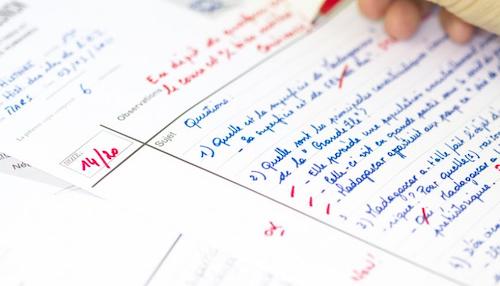
Réviser le bac avec les sujets des années précédentes
Les annales sont un outil précieux pour les étudiants qui se préparent à leur bac. Elles permettent de s'entraîner sur des sujets et des questions similaires à ceux qui pourraient être posés lors de l'examen final. En utilisant les annales, les étudiants peuvent développer leur compréhension des matières, améliorer leur…

Trouvez des cours de soutien scolaire près de chez vous avec captaincours
Dès la 3ème, et encore plus au lycée, le rythme scolaire s'accélère. Les professeurs sont plus exigeants, les matières plus pointues et il est courant de rencontrer des difficultés en cours ou pendant le travail après les cours. Le choix des spécialités, depuis la réforme du lycée, impose notamment des…
www.admis-examen.fr est titulaire d'une licence de réutilisation des données publiques accordée par l'Éducation Nationale . Cette licence, accordée à titre non exclusif, permet la diffusion des résultats des BAC, brevet des collèges, CAP, BEP, BTS 2024
Tous les résultats et les dates de résultats nous sont communiqués directement par l'Éducation Nationale via les académies dès les décisions des jurys d'examen validés, ainsi les résultats sont immédiatements disponibles.
Vous pourrez aussi trouver les résultats après leur publication sur le site de l'Éducation Nationale et des examens agricoles
Les résultats des candidats ayant souhaité ne pas apparaître ne sont pas publiés.
- Résultats du Bac 2024
- Résultats du Brevet 2024
- Résultats du BTS 2024
- Résultats du CAP 2024
- Aix Marseille
- International
- Montpellier
- Orléans-Tours
- Résultats du BAC 2024 par départements
- Résultats du BAC PRO 2024 par départements
- Résultats du BAC TECHNO 2024 par départements
- Résultats du BREVET 2024 par départements
- Résultats du BREVET PRO 2024 par départements
- Résultats du BTS 2024 par départements
- Résultats du CAP 2024 par départements
- Résultats du DIPLOMES COMPTABLES SUPERIEURS 2024 par départements
- Résultats du MENTION COMPLEMENTAIRE NIVEAU 3 2024 par départements
- Résultats du MENTION COMPLEMENTAIRE NIVEAU 4 2024 par départements
Évitez les fautes dans vos écrits académiques
Évitez le plagiat gratuitement, faire une bibliographie gratuitement.
- Dissertation
6 étapes incontournables pour réaliser une dissertation
Publié le 2 octobre 2019 par Justine Debret . Mis à jour le 31 janvier 2024.
En français, la dissertation est un exercice d’argumentation qui se construit en 6 étapes. Nous allons vous expliquer comment faire une dissertation de A à Z.
Pour faire une dissertation, c’est très simple :
- Lire et analyser le sujet
- Trouver la problématique
- Faire le plan de la dissertation
- Rédiger l’introduction
- Rédiger le développement
- Faire la conclusion
Pour tout comprendre sur comment faire une dissertation, nous allons utiliser un exemple concret issu des annales du Bac S de philosophie de 2019.
Table des matières
1. lire et analyser le sujet, 2. trouver la problématique, 3. faire le plan de la dissertation, 4. rédiger l’introduction, 5. rédiger le développement de la dissertation, 6. ecrire la conclusion, présentation gratuite.
Vous allez devoir produire une réflexion organisée sur un sujet spécifique qui vous est imposé.
Le sujet peut être :
- une question
- un thème ou concept
- une citation
Si vous avez le choix entre plusieurs sujets, sélectionnez celui qui vous inspire le plus et sur lequel vous avez le plus de connaissances. Il faudra le choisir rapidement si vous devez faire une dissertation lors d’un examen de quelques heures (dans les 10 premières minutes).
Une fois le sujet choisi, vous allez devoir définir chaque terme présent dans l’intitulé, afin de mieux le comprendre.
Exemple : Reconnaître ses devoirs, est-ce renoncer à sa liberté ?
Essayez ensuite de reformuler le sujet complètement à partir de vos définitions ou de synonymes.
Corriger des textes efficacement et rapidement
Corrigez des phrases, des paragraphes ou des textes entiers en un clin d'œil grâce à notre correcteur d'orthographe gratuit.
Corriger un texte gratuitement
Lisez plusieurs fois la reformulation du sujet rédigée à partir de vos définitions. Au brouillon, écrivez toutes les idées qui vous viennent à l’esprit sur le sujet (exemples, auteurs, événements, …).
C’est à partir de ces connaissances et votre reformulation que vous allez pouvoir trouver votre problématique.
Petit conseil ! Utilisez cette question clé : à quel(s) problème(s) ces connaissances tentent-elles de répondre ?
Une question centrale va émerger et c’est à partir de cette dernière que votre dissertation va se construire pour créer un débat où s’affrontent des thèses divergentes.
Le plan d’une dissertation peut prendre diverses formes. L’important est qu’il réponde bien à votre problématique pour que vous évitiez le hors-sujet.
- Utilisez votre brouillon initial sur lequel vous avez noté vos idées.
- Classez ensuite ces idées par thématique ou argument.
- Normalement, vous pourrez arriver à deux ou trois idées principales, divisées en deux ou trois sous-parties qui seront illustrées par des exemples concrets.
- N’oubliez pas de rédiger une transition entre chaque grande partie (conclusion de la partie actuelle et introduction de la partie suivante).
I) Les devoirs de l’Homme, une soumission naturelle et nécessaire ?
1) Les devoirs, un concept pluriel et contextuel -> Expliquez ici quels sont les différents devoirs que nous rencontrons et en quoi il divergent en fonction des cultures et systèmes étatiques. -> L’existence de devoirs pluriels (travail, citoyenneté, devoir par rapport à la famille, devoir scolaire, droits et devoirs de l’Homme).
2) L’Homme contraint par nature ? -> Concept de contrainte imposée par la nature sur l’Homme (la nature de l’Homme). -> Hobbes et “l’Homme est un loup pour l’Homme” : il abandonne sa liberté et vit en société pour survivre car la nature de l’Homme est agressive.
3) L’Homme : un animal social contraint pour sa liberté ? -> Aristote parlait du concept d’”animal social”. -> Le devoir de morale et d’empathie chez Rousseau fait qu’un être est humain (naturellement) et sociable. -> Sartre et son concept de liberté et libre arbitre : l’Homme est libre et responsable de ses actes naturellement (c’est inné). C’est pour cela qu’il peut vivre en société.
– TRANSITION –
II) La libération de l’Homme par le devoir
1) La culture libératrice -> Le devoir nous permet de nous cultiver et donc de nous libérer de la nature qui est en nous (Kant). -> L’école et l’éducation, le vote, … sont des droits et devoirs qui nous libèrent de notre ignorance naturelle (innée) et de la contrainte du déterminisme. -> Freud et les pulsions de l’Homme qui sont contrôlées intérieurement pas le surmoi. La pression sociale et les devoirs sociaux nous permettent de nous libérer de nos pulsions et désirs en les rejetant dans le ca.
2) Le travail comme contrainte de libération quotidienne -> Le concept de travail comme contrainte/liberté (apporte l’estime de soi, mais nous contraint lourdement) avec Platon, Marx (“l’opium du peuple”) et Kant.
3) La reconnaissance comme liberté -> Kant définit l’autonomie comme la capacité à se donner ses propres règles et de les suivre. La liberté ne consiste donc pas à échapper à toute règle, à tout devoir, mais à se les donner et à y soumettre ses actes. -> Exemple du devoir de mémoire des survivants de la Seconde Guerre mondiale : processus de libération psychologique personnelle et rôle de devoir citoyen.
L’introduction d’une dissertation doit suivre une structure stricte. Elle introduit le sujet, la problématique et le plan.
Les parties d’une introduction de dissertation sont :
- Une amorce ou phrase d’accroche.
- L’énoncé du sujet.
- La définition des termes et reformulation du sujet.
- La problématique.
- L’annonce du plan.
Le droit de vote est considéré par les institutions comme un devoir moral pour les citoyens, comme le rappelle l’inscription figurant sur les cartes électorales : « Voter est un droit, c’est aussi un devoir civique ».
Les devoirs explicitent un comportement à suivre ou à ne pas suivre. Ils préconisent la conformité avec une règle. Cette notion semble en contradiction avec celle de la liberté, car le devoir s’opposerait à une impulsion ou un désir qui définirait notre liberté.
Toutefois, cette conception de la liberté est naïve et limitée, car être libre ne consiste pas à faire ce que l’on veut. De même, le devoir ne se limite pas à une contrainte imposée de l’extérieur. Il peut s’agit d’une obligation qu l’on décide de s’imposer librement.
Nous questionnons donc ces concepts en essayant de répondre à la problématique suivante : peut-on vraiment dire qu’on renonce à sa liberté quand on fait le choix de se soumettre à ses devoirs, quand on exerce donc sa liberté avec son libre-arbitre ?
Notre raisonnement questionnera tout d’abord les devoirs de l’Homme comme une soumission naturelle et nécessaire (I), avant d’interroger la possible libération de l’Homme par le devoir (II).
Quel est votre taux de plagiat ?
En 10 minutes, vous pouvez savoir si vous avez commis du plagiat et comment l’éliminer.
- La technologie de Turnitin
- Un résumé de toutes les sources trouvées
- Une comparaison avec une base de données énorme
Faites la détection anti-plagiat

Le développement d’une dissertation comporte toujours deux ou trois parties. Si vous faites une dissertation en deux parties, vous devrez rédiger trois sous-parties pour chacune (deux si vous faites trois grandes parties).
Chaque partie soutient une idée centrale qui répond à la problématique, alors que chaque sous-partie s’articule autour d’un argument qui soutient et illustre l’idée directrice.
Vos arguments doivent absolument être illustrés par un exemple !
Entre chaque partie, vous devez rédiger une transition qui conclut la partie précédente et annonce la partie suivante.
La conclusion d’une dissertation est une brève synthèse du développement en indiquant nettement la réponse à la question posée dans l’introduction. Il est aussi possible d’ajouter une ouverture à la fin.
Notre étude a montré qu’au-delà du poids contraignant des devoirs que l’on peut sentir au premier abord, ils n’entravent pas notre réelle liberté. Bien au contraire, nos devoirs nous libèrent de la nature humaine qui est en nous et qui nous rend esclave de nos pulsions, désirs et violence interne. Reconnaître ses devoirs et les accepter, contribue à entretenir notre puissance d’agir et donc notre liberté.
Le concept de devoir reste très lié à celui de droit dans les démocraties occidentales. Le droit de vote est-il libérateur ?
Voici une présentation que vous pouvez utiliser pour vous améliorer ou partager nos conseils méthodologiques sur la dissertation. N’hésitez pas à la partager ou à l’utiliser lors de vos cours :).
Sur Google Slides En version PowerPoint
Citer cet article de Scribbr
Si vous souhaitez citer cette source, vous pouvez la copier/coller ou cliquer sur le bouton “Citez cet article” pour l’ajouter automatiquement à notre Générateur de sources gratuit.
Debret, J. (2024, 31 janvier). 6 étapes incontournables pour réaliser une dissertation. Scribbr. Consulté le 9 mai 2024, de https://www.scribbr.fr/dissertation-fr/comment-faire-une-dissertation/
Cet article est-il utile ?
Justine Debret
D'autres étudiants ont aussi consulté..., conclusion d’une dissertation : comment la rédiger , essay : comment faire une dissertation en anglais , introduction de dissertation.
Dissertation Structure & Layout 101: How to structure your dissertation, thesis or research project.
By: Derek Jansen (MBA) Reviewed By: David Phair (PhD) | July 2019
So, you’ve got a decent understanding of what a dissertation is , you’ve chosen your topic and hopefully you’ve received approval for your research proposal . Awesome! Now its time to start the actual dissertation or thesis writing journey.
To craft a high-quality document, the very first thing you need to understand is dissertation structure . In this post, we’ll walk you through the generic dissertation structure and layout, step by step. We’ll start with the big picture, and then zoom into each chapter to briefly discuss the core contents. If you’re just starting out on your research journey, you should start with this post, which covers the big-picture process of how to write a dissertation or thesis .

*The Caveat *
In this post, we’ll be discussing a traditional dissertation/thesis structure and layout, which is generally used for social science research across universities, whether in the US, UK, Europe or Australia. However, some universities may have small variations on this structure (extra chapters, merged chapters, slightly different ordering, etc).
So, always check with your university if they have a prescribed structure or layout that they expect you to work with. If not, it’s safe to assume the structure we’ll discuss here is suitable. And even if they do have a prescribed structure, you’ll still get value from this post as we’ll explain the core contents of each section.
Overview: S tructuring a dissertation or thesis
- Acknowledgements page
- Abstract (or executive summary)
- Table of contents , list of figures and tables
- Chapter 1: Introduction
- Chapter 2: Literature review
- Chapter 3: Methodology
- Chapter 4: Results
- Chapter 5: Discussion
- Chapter 6: Conclusion
- Reference list
As I mentioned, some universities will have slight variations on this structure. For example, they want an additional “personal reflection chapter”, or they might prefer the results and discussion chapter to be merged into one. Regardless, the overarching flow will always be the same, as this flow reflects the research process , which we discussed here – i.e.:
- The introduction chapter presents the core research question and aims .
- The literature review chapter assesses what the current research says about this question.
- The methodology, results and discussion chapters go about undertaking new research about this question.
- The conclusion chapter (attempts to) answer the core research question .
In other words, the dissertation structure and layout reflect the research process of asking a well-defined question(s), investigating, and then answering the question – see below.

To restate that – the structure and layout of a dissertation reflect the flow of the overall research process . This is essential to understand, as each chapter will make a lot more sense if you “get” this concept. If you’re not familiar with the research process, read this post before going further.
Right. Now that we’ve covered the big picture, let’s dive a little deeper into the details of each section and chapter. Oh and by the way, you can also grab our free dissertation/thesis template here to help speed things up.
The title page of your dissertation is the very first impression the marker will get of your work, so it pays to invest some time thinking about your title. But what makes for a good title? A strong title needs to be 3 things:
- Succinct (not overly lengthy or verbose)
- Specific (not vague or ambiguous)
- Representative of the research you’re undertaking (clearly linked to your research questions)
Typically, a good title includes mention of the following:
- The broader area of the research (i.e. the overarching topic)
- The specific focus of your research (i.e. your specific context)
- Indication of research design (e.g. quantitative , qualitative , or mixed methods ).
For example:
A quantitative investigation [research design] into the antecedents of organisational trust [broader area] in the UK retail forex trading market [specific context/area of focus].
Again, some universities may have specific requirements regarding the format and structure of the title, so it’s worth double-checking expectations with your institution (if there’s no mention in the brief or study material).

Acknowledgements
This page provides you with an opportunity to say thank you to those who helped you along your research journey. Generally, it’s optional (and won’t count towards your marks), but it is academic best practice to include this.
So, who do you say thanks to? Well, there’s no prescribed requirements, but it’s common to mention the following people:
- Your dissertation supervisor or committee.
- Any professors, lecturers or academics that helped you understand the topic or methodologies.
- Any tutors, mentors or advisors.
- Your family and friends, especially spouse (for adult learners studying part-time).
There’s no need for lengthy rambling. Just state who you’re thankful to and for what (e.g. thank you to my supervisor, John Doe, for his endless patience and attentiveness) – be sincere. In terms of length, you should keep this to a page or less.
Abstract or executive summary
The dissertation abstract (or executive summary for some degrees) serves to provide the first-time reader (and marker or moderator) with a big-picture view of your research project. It should give them an understanding of the key insights and findings from the research, without them needing to read the rest of the report – in other words, it should be able to stand alone .
For it to stand alone, your abstract should cover the following key points (at a minimum):
- Your research questions and aims – what key question(s) did your research aim to answer?
- Your methodology – how did you go about investigating the topic and finding answers to your research question(s)?
- Your findings – following your own research, what did do you discover?
- Your conclusions – based on your findings, what conclusions did you draw? What answers did you find to your research question(s)?
So, in much the same way the dissertation structure mimics the research process, your abstract or executive summary should reflect the research process, from the initial stage of asking the original question to the final stage of answering that question.
In practical terms, it’s a good idea to write this section up last , once all your core chapters are complete. Otherwise, you’ll end up writing and rewriting this section multiple times (just wasting time). For a step by step guide on how to write a strong executive summary, check out this post .
Need a helping hand?
Table of contents
This section is straightforward. You’ll typically present your table of contents (TOC) first, followed by the two lists – figures and tables. I recommend that you use Microsoft Word’s automatic table of contents generator to generate your TOC. If you’re not familiar with this functionality, the video below explains it simply:
If you find that your table of contents is overly lengthy, consider removing one level of depth. Oftentimes, this can be done without detracting from the usefulness of the TOC.
Right, now that the “admin” sections are out of the way, its time to move on to your core chapters. These chapters are the heart of your dissertation and are where you’ll earn the marks. The first chapter is the introduction chapter – as you would expect, this is the time to introduce your research…
It’s important to understand that even though you’ve provided an overview of your research in your abstract, your introduction needs to be written as if the reader has not read that (remember, the abstract is essentially a standalone document). So, your introduction chapter needs to start from the very beginning, and should address the following questions:
- What will you be investigating (in plain-language, big picture-level)?
- Why is that worth investigating? How is it important to academia or business? How is it sufficiently original?
- What are your research aims and research question(s)? Note that the research questions can sometimes be presented at the end of the literature review (next chapter).
- What is the scope of your study? In other words, what will and won’t you cover ?
- How will you approach your research? In other words, what methodology will you adopt?
- How will you structure your dissertation? What are the core chapters and what will you do in each of them?
These are just the bare basic requirements for your intro chapter. Some universities will want additional bells and whistles in the intro chapter, so be sure to carefully read your brief or consult your research supervisor.
If done right, your introduction chapter will set a clear direction for the rest of your dissertation. Specifically, it will make it clear to the reader (and marker) exactly what you’ll be investigating, why that’s important, and how you’ll be going about the investigation. Conversely, if your introduction chapter leaves a first-time reader wondering what exactly you’ll be researching, you’ve still got some work to do.
Now that you’ve set a clear direction with your introduction chapter, the next step is the literature review . In this section, you will analyse the existing research (typically academic journal articles and high-quality industry publications), with a view to understanding the following questions:
- What does the literature currently say about the topic you’re investigating?
- Is the literature lacking or well established? Is it divided or in disagreement?
- How does your research fit into the bigger picture?
- How does your research contribute something original?
- How does the methodology of previous studies help you develop your own?
Depending on the nature of your study, you may also present a conceptual framework towards the end of your literature review, which you will then test in your actual research.
Again, some universities will want you to focus on some of these areas more than others, some will have additional or fewer requirements, and so on. Therefore, as always, its important to review your brief and/or discuss with your supervisor, so that you know exactly what’s expected of your literature review chapter.

Now that you’ve investigated the current state of knowledge in your literature review chapter and are familiar with the existing key theories, models and frameworks, its time to design your own research. Enter the methodology chapter – the most “science-ey” of the chapters…
In this chapter, you need to address two critical questions:
- Exactly HOW will you carry out your research (i.e. what is your intended research design)?
- Exactly WHY have you chosen to do things this way (i.e. how do you justify your design)?
Remember, the dissertation part of your degree is first and foremost about developing and demonstrating research skills . Therefore, the markers want to see that you know which methods to use, can clearly articulate why you’ve chosen then, and know how to deploy them effectively.
Importantly, this chapter requires detail – don’t hold back on the specifics. State exactly what you’ll be doing, with who, when, for how long, etc. Moreover, for every design choice you make, make sure you justify it.
In practice, you will likely end up coming back to this chapter once you’ve undertaken all your data collection and analysis, and revise it based on changes you made during the analysis phase. This is perfectly fine. Its natural for you to add an additional analysis technique, scrap an old one, etc based on where your data lead you. Of course, I’m talking about small changes here – not a fundamental switch from qualitative to quantitative, which will likely send your supervisor in a spin!
You’ve now collected your data and undertaken your analysis, whether qualitative, quantitative or mixed methods. In this chapter, you’ll present the raw results of your analysis . For example, in the case of a quant study, you’ll present the demographic data, descriptive statistics, inferential statistics , etc.
Typically, Chapter 4 is simply a presentation and description of the data, not a discussion of the meaning of the data. In other words, it’s descriptive, rather than analytical – the meaning is discussed in Chapter 5. However, some universities will want you to combine chapters 4 and 5, so that you both present and interpret the meaning of the data at the same time. Check with your institution what their preference is.
Now that you’ve presented the data analysis results, its time to interpret and analyse them. In other words, its time to discuss what they mean, especially in relation to your research question(s).
What you discuss here will depend largely on your chosen methodology. For example, if you’ve gone the quantitative route, you might discuss the relationships between variables . If you’ve gone the qualitative route, you might discuss key themes and the meanings thereof. It all depends on what your research design choices were.
Most importantly, you need to discuss your results in relation to your research questions and aims, as well as the existing literature. What do the results tell you about your research questions? Are they aligned with the existing research or at odds? If so, why might this be? Dig deep into your findings and explain what the findings suggest, in plain English.
The final chapter – you’ve made it! Now that you’ve discussed your interpretation of the results, its time to bring it back to the beginning with the conclusion chapter . In other words, its time to (attempt to) answer your original research question s (from way back in chapter 1). Clearly state what your conclusions are in terms of your research questions. This might feel a bit repetitive, as you would have touched on this in the previous chapter, but its important to bring the discussion full circle and explicitly state your answer(s) to the research question(s).

Next, you’ll typically discuss the implications of your findings? In other words, you’ve answered your research questions – but what does this mean for the real world (or even for academia)? What should now be done differently, given the new insight you’ve generated?
Lastly, you should discuss the limitations of your research, as well as what this means for future research in the area. No study is perfect, especially not a Masters-level. Discuss the shortcomings of your research. Perhaps your methodology was limited, perhaps your sample size was small or not representative, etc, etc. Don’t be afraid to critique your work – the markers want to see that you can identify the limitations of your work. This is a strength, not a weakness. Be brutal!
This marks the end of your core chapters – woohoo! From here on out, it’s pretty smooth sailing.
The reference list is straightforward. It should contain a list of all resources cited in your dissertation, in the required format, e.g. APA , Harvard, etc.
It’s essential that you use reference management software for your dissertation. Do NOT try handle your referencing manually – its far too error prone. On a reference list of multiple pages, you’re going to make mistake. To this end, I suggest considering either Mendeley or Zotero. Both are free and provide a very straightforward interface to ensure that your referencing is 100% on point. I’ve included a simple how-to video for the Mendeley software (my personal favourite) below:
Some universities may ask you to include a bibliography, as opposed to a reference list. These two things are not the same . A bibliography is similar to a reference list, except that it also includes resources which informed your thinking but were not directly cited in your dissertation. So, double-check your brief and make sure you use the right one.
The very last piece of the puzzle is the appendix or set of appendices. This is where you’ll include any supporting data and evidence. Importantly, supporting is the keyword here.
Your appendices should provide additional “nice to know”, depth-adding information, which is not critical to the core analysis. Appendices should not be used as a way to cut down word count (see this post which covers how to reduce word count ). In other words, don’t place content that is critical to the core analysis here, just to save word count. You will not earn marks on any content in the appendices, so don’t try to play the system!
Time to recap…
And there you have it – the traditional dissertation structure and layout, from A-Z. To recap, the core structure for a dissertation or thesis is (typically) as follows:
- Acknowledgments page
Most importantly, the core chapters should reflect the research process (asking, investigating and answering your research question). Moreover, the research question(s) should form the golden thread throughout your dissertation structure. Everything should revolve around the research questions, and as you’ve seen, they should form both the start point (i.e. introduction chapter) and the endpoint (i.e. conclusion chapter).
I hope this post has provided you with clarity about the traditional dissertation/thesis structure and layout. If you have any questions or comments, please leave a comment below, or feel free to get in touch with us. Also, be sure to check out the rest of the Grad Coach Blog .

Psst... there’s more!
This post was based on one of our popular Research Bootcamps . If you're working on a research project, you'll definitely want to check this out ...
You Might Also Like:

36 Comments
many thanks i found it very useful
Glad to hear that, Arun. Good luck writing your dissertation.
Such clear practical logical advice. I very much needed to read this to keep me focused in stead of fretting.. Perfect now ready to start my research!
what about scientific fields like computer or engineering thesis what is the difference in the structure? thank you very much
Thanks so much this helped me a lot!
Very helpful and accessible. What I like most is how practical the advice is along with helpful tools/ links.
Thanks Ade!
Thank you so much sir.. It was really helpful..
You’re welcome!
Hi! How many words maximum should contain the abstract?
Thank you so much 😊 Find this at the right moment
You’re most welcome. Good luck with your dissertation.
best ever benefit i got on right time thank you
Many times Clarity and vision of destination of dissertation is what makes the difference between good ,average and great researchers the same way a great automobile driver is fast with clarity of address and Clear weather conditions .
I guess Great researcher = great ideas + knowledge + great and fast data collection and modeling + great writing + high clarity on all these
You have given immense clarity from start to end.
Morning. Where will I write the definitions of what I’m referring to in my report?
Thank you so much Derek, I was almost lost! Thanks a tonnnn! Have a great day!
Thanks ! so concise and valuable
This was very helpful. Clear and concise. I know exactly what to do now.
Thank you for allowing me to go through briefly. I hope to find time to continue.
Really useful to me. Thanks a thousand times
Very interesting! It will definitely set me and many more for success. highly recommended.
Thank you soo much sir, for the opportunity to express my skills
Usefull, thanks a lot. Really clear
Very nice and easy to understand. Thank you .
That was incredibly useful. Thanks Grad Coach Crew!
My stress level just dropped at least 15 points after watching this. Just starting my thesis for my grad program and I feel a lot more capable now! Thanks for such a clear and helpful video, Emma and the GradCoach team!
Do we need to mention the number of words the dissertation contains in the main document?
It depends on your university’s requirements, so it would be best to check with them 🙂
Such a helpful post to help me get started with structuring my masters dissertation, thank you!
Great video; I appreciate that helpful information
It is so necessary or avital course
This blog is very informative for my research. Thank you
Doctoral students are required to fill out the National Research Council’s Survey of Earned Doctorates
wow this is an amazing gain in my life
This is so good
How can i arrange my specific objectives in my dissertation?
Trackbacks/Pingbacks
- What Is A Literature Review (In A Dissertation Or Thesis) - Grad Coach - […] is to write the actual literature review chapter (this is usually the second chapter in a typical dissertation or…
Submit a Comment Cancel reply
Your email address will not be published. Required fields are marked *
Save my name, email, and website in this browser for the next time I comment.
- Print Friendly
Have a language expert improve your writing
Run a free plagiarism check in 10 minutes, automatically generate references for free.
- Knowledge Base
- Dissertation
What Is a Dissertation? | 5 Essential Questions to Get Started
Published on 26 March 2020 by Jack Caulfield . Revised on 5 May 2022.
A dissertation is a large research project undertaken at the end of a degree. It involves in-depth consideration of a problem or question chosen by the student. It is usually the largest (and final) piece of written work produced during a degree.
The length and structure of a dissertation vary widely depending on the level and field of study. However, there are some key questions that can help you understand the requirements and get started on your dissertation project.
Instantly correct all language mistakes in your text
Be assured that you'll submit flawless writing. Upload your document to correct all your mistakes.

Table of contents
When and why do you have to write a dissertation, who will supervise your dissertation, what type of research will you do, how should your dissertation be structured, what formatting and referencing rules do you have to follow, frequently asked questions about dissertations.
A dissertation, sometimes called a thesis, comes at the end of an undergraduate or postgraduate degree. It is a larger project than the other essays you’ve written, requiring a higher word count and a greater depth of research.
You’ll generally work on your dissertation during the final year of your degree, over a longer period than you would take for a standard essay . For example, the dissertation might be your main focus for the last six months of your degree.
Why is the dissertation important?
The dissertation is a test of your capacity for independent research. You are given a lot of autonomy in writing your dissertation: you come up with your own ideas, conduct your own research, and write and structure the text by yourself.
This means that it is an important preparation for your future, whether you continue in academia or not: it teaches you to manage your own time, generate original ideas, and work independently.
Prevent plagiarism, run a free check.
During the planning and writing of your dissertation, you’ll work with a supervisor from your department. The supervisor’s job is to give you feedback and advice throughout the process.
The dissertation supervisor is often assigned by the department, but you might be allowed to indicate preferences or approach potential supervisors. If so, try to pick someone who is familiar with your chosen topic, whom you get along with on a personal level, and whose feedback you’ve found useful in the past.
How will your supervisor help you?
Your supervisor is there to guide you through the dissertation project, but you’re still working independently. They can give feedback on your ideas, but not come up with ideas for you.
You may need to take the initiative to request an initial meeting with your supervisor. Then you can plan out your future meetings and set reasonable deadlines for things like completion of data collection, a structure outline, a first chapter, a first draft, and so on.
Make sure to prepare in advance for your meetings. Formulate your ideas as fully as you can, and determine where exactly you’re having difficulties so you can ask your supervisor for specific advice.
Your approach to your dissertation will vary depending on your field of study. The first thing to consider is whether you will do empirical research , which involves collecting original data, or non-empirical research , which involves analysing sources.
Empirical dissertations (sciences)
An empirical dissertation focuses on collecting and analysing original data. You’ll usually write this type of dissertation if you are studying a subject in the sciences or social sciences.
- What are airline workers’ attitudes towards the challenges posed for their industry by climate change?
- How effective is cognitive behavioural therapy in treating depression in young adults?
- What are the short-term health effects of switching from smoking cigarettes to e-cigarettes?
There are many different empirical research methods you can use to answer these questions – for example, experiments , observations, surveys , and interviews.
When doing empirical research, you need to consider things like the variables you will investigate, the reliability and validity of your measurements, and your sampling method . The aim is to produce robust, reproducible scientific knowledge.
Non-empirical dissertations (arts and humanities)
A non-empirical dissertation works with existing research or other texts, presenting original analysis, critique and argumentation, but no original data. This approach is typical of arts and humanities subjects.
- What attitudes did commentators in the British press take towards the French Revolution in 1789–1792?
- How do the themes of gender and inheritance intersect in Shakespeare’s Macbeth ?
- How did Plato’s Republic and Thomas More’s Utopia influence nineteenth century utopian socialist thought?
The first steps in this type of dissertation are to decide on your topic and begin collecting your primary and secondary sources .
Primary sources are the direct objects of your research. They give you first-hand evidence about your subject. Examples of primary sources include novels, artworks and historical documents.
Secondary sources provide information that informs your analysis. They describe, interpret, or evaluate information from primary sources. For example, you might consider previous analyses of the novel or author you are working on, or theoretical texts that you plan to apply to your primary sources.
Dissertations are divided into chapters and sections. Empirical dissertations usually follow a standard structure, while non-empirical dissertations are more flexible.
Structure of an empirical dissertation
Empirical dissertations generally include these chapters:
- Introduction : An explanation of your topic and the research question(s) you want to answer.
- Literature review : A survey and evaluation of previous research on your topic.
- Methodology : An explanation of how you collected and analysed your data.
- Results : A brief description of what you found.
- Discussion : Interpretation of what these results reveal.
- Conclusion : Answers to your research question(s) and summary of what your findings contribute to knowledge in your field.
Sometimes the order or naming of chapters might be slightly different, but all of the above information must be included in order to produce thorough, valid scientific research.
Other dissertation structures
If your dissertation doesn’t involve data collection, your structure is more flexible. You can think of it like an extended essay – the text should be logically organised in a way that serves your argument:
- Introduction: An explanation of your topic and the question(s) you want to answer.
- Main body: The development of your analysis, usually divided into 2–4 chapters.
- Conclusion: Answers to your research question(s) and summary of what your analysis contributes to knowledge in your field.
The chapters of the main body can be organised around different themes, time periods, or texts. Below you can see some example structures for dissertations in different subjects.
- Political philosophy
This example, on the topic of the British press’s coverage of the French Revolution, shows how you might structure each chapter around a specific theme.

This example, on the topic of Plato’s and More’s influences on utopian socialist thought, shows a different approach to dividing the chapters by theme.

This example, a master’s dissertation on the topic of how writers respond to persecution, shows how you can also use section headings within each chapter. Each of the three chapters deals with a specific text, while the sections are organised thematically.

The only proofreading tool specialized in correcting academic writing
The academic proofreading tool has been trained on 1000s of academic texts and by native English editors. Making it the most accurate and reliable proofreading tool for students.

Correct my document today
Like other academic texts, it’s important that your dissertation follows the formatting guidelines set out by your university. You can lose marks unnecessarily over mistakes, so it’s worth taking the time to get all these elements right.
Formatting guidelines concern things like:
- line spacing
- page numbers
- punctuation
- title pages
- presentation of tables and figures
If you’re unsure about the formatting requirements, check with your supervisor or department. You can lose marks unnecessarily over mistakes, so it’s worth taking the time to get all these elements right.
How will you reference your sources?
Referencing means properly listing the sources you cite and refer to in your dissertation, so that the reader can find them. This avoids plagiarism by acknowledging where you’ve used the work of others.
Keep track of everything you read as you prepare your dissertation. The key information to note down for a reference is:
- The publication date
- Page numbers for the parts you refer to (especially when using direct quotes)
Different referencing styles each have their own specific rules for how to reference. The most commonly used styles in UK universities are listed below.
You can use the free APA Reference Generator to automatically create and store your references.
APA Reference Generator
The words ‘ dissertation ’ and ‘thesis’ both refer to a large written research project undertaken to complete a degree, but they are used differently depending on the country:
- In the UK, you write a dissertation at the end of a bachelor’s or master’s degree, and you write a thesis to complete a PhD.
- In the US, it’s the other way around: you may write a thesis at the end of a bachelor’s or master’s degree, and you write a dissertation to complete a PhD.
The main difference is in terms of scale – a dissertation is usually much longer than the other essays you complete during your degree.
Another key difference is that you are given much more independence when working on a dissertation. You choose your own dissertation topic , and you have to conduct the research and write the dissertation yourself (with some assistance from your supervisor).
Dissertation word counts vary widely across different fields, institutions, and levels of education:
- An undergraduate dissertation is typically 8,000–15,000 words
- A master’s dissertation is typically 12,000–50,000 words
- A PhD thesis is typically book-length: 70,000–100,000 words
However, none of these are strict guidelines – your word count may be lower or higher than the numbers stated here. Always check the guidelines provided by your university to determine how long your own dissertation should be.
At the bachelor’s and master’s levels, the dissertation is usually the main focus of your final year. You might work on it (alongside other classes) for the entirety of the final year, or for the last six months. This includes formulating an idea, doing the research, and writing up.
A PhD thesis takes a longer time, as the thesis is the main focus of the degree. A PhD thesis might be being formulated and worked on for the whole four years of the degree program. The writing process alone can take around 18 months.
Cite this Scribbr article
If you want to cite this source, you can copy and paste the citation or click the ‘Cite this Scribbr article’ button to automatically add the citation to our free Reference Generator.
Caulfield, J. (2022, May 05). What Is a Dissertation? | 5 Essential Questions to Get Started. Scribbr. Retrieved 6 May 2024, from https://www.scribbr.co.uk/thesis-dissertation/what-is-a-dissertation/
Is this article helpful?

Jack Caulfield
Other students also liked, how to choose a dissertation topic | 8 steps to follow, how to write a dissertation proposal | a step-by-step guide, what is a literature review | guide, template, & examples.
- Concours Écoles Agro Véto
- Concours Écoles d'ingénieurs
- Concours Écoles de commerce
- Concours Écoles de journalisme
- Concours Enseignement
- Concours Fonction publique : Administration
- Concours Fonction publique : Culture, Patrimoine
- Concours Fonction publique : Défense, Police, Justice
- Concours Fonction publique : Economie, Finances, Douanes, Travail
- Concours Fonction publique : Education, Animation, Sport, Social
- Concours Fonction publique : Technique, Sciences
- Concours IEP /Sciences Po
- Concours Santé Paramédical Social
- Diplômes comptables
- Ecoles d'Art / Architecture
- Réussir à l'université / IAE
- Réussir le Brevet des collèges (DNB)
- Réussir les tests de langues
- Réussir son BTS
- Réussir son BUT
- Méthodologie (Partie 1) - la dissertation
Plan de la fiche
- Comment faire ?
- L'introduction
- Le développement
- La conclusion
Organisation et déroulement de l'épreuve de spécialité HGGSP
L'épreuve ponctuelle de spécialité HGGSP est d'une durée totale de 4 heures. Comme pour les épreuves de tronc commun de Première, une banque de données de sujets sera accessible pour que vous puissiez vous entraîner. L'épreuve porte sur la partie du programme de l'enseignement de spécialité traité durant l'année de Terminale, mais uniquement sur certains thèmes, à savoir :
- Les thèmes 1, 2, 3 et 5 les années paires.
- Les thèmes 2, 4, 5 et 6 les années impaires, ce qui sera le cas en 2021.
Lire la suite de la fiche ci-dessous et la télécharger :
Les autres fiches de révisions
Identifier, protéger et valoriser le patrimoine : enjeux géopolitiques.
- Identifier, protéger et valoriser le patrimoine - le cours
L'environnement, entre exploitation et protection : un enjeu planétaire
- L'environnement, entre exploitation et protection : un enjeu planétaire - le cours
Faire la guerre, faire la paix : formes de conflits et modes de résolution
- Faire la guerre, faire la paix : formes de conflits et modes de résolution - le cours (Partie 1)
- Faire la guerre, faire la paix : formes de conflits et modes de résolution - le cours (Partie 2)
Fiches méthodologie Histoire-Géographie, Géopolitique et Sciences Politiques – Terminale
- Méthodologie (Partie 2) - l'étude critique de documents
Décrochez votre Bac 2024 avec Studyrama !
- Poursuivre ses études après le bac
- Fiches de révision du Bac 2024
- Bac 2024 : les dates et épreuves
- Les sujets et corrigés du Bac 2024
- Que faire avec ou sans le bac...
- Résultats du Bac 2024 : dates, heures et résultats par académies
- Ce qu’il faut savoir sur Alexandre Koyré
- Fiche Paul Krugman : théories, modèle, ouvrages
- Thème grammatical espagnol sur l’actualité péruvienne
- La construction des États africains
- La maîtrise de l’anglais, indispensable pour sa carrière ?

Laissez-nous vous aider, Indiquez ce que vous cherchez en quelques mots !
Pour vous faciliter la navigation sur le site, Mister prépa vous sélectionne tous les articles en relation avec votre recherche.

Organiser son temps pour les dissertations en 4 heures
Si vous préparez les écoles de commerce en khâgne, vous savez que parmi les six épreuves supplémentaires de la BCE, trois sont des dissertations . Celles-ci sont spécifiques à la filière littéraire, contrairement aux trois autres pour lesquelles vous pouvez trouver des conseils et des instructions dans de nombreux autres articles destinés aux ECG.
Lire plus : Les différentes méthodes qui fonctionnent en contraction
Souvent la préparation à ces dissertations est sous-estimée : nous en faisons depuis deux ans : deux heures d’épreuve en moins semblent ne pas changer grand-chose. Pourtant, chaque année, de nombreux élèves de filière littéraire sont déçus par leurs notes aux écrits de la BCE où ils obtiennent parfois des notes bien inférieures à celles de l’ENS. Mais pas d’inquiétude, à l’inverse, certains sont agréablement surpris par leurs résultats : j’ai, par exemple, obtenu 9 points de plus en géographie à la BCE qu’à l’ENS.
La plus grande différence est évidemment la durée , c’est donc par là qu’il faut commencer. Chacun gère différemment son temps aux écrits en 6 heures, mais rares sont ceux qui passent moins de deux heures au brouillon. Je passais exactement trois heures au brouillon, et en préparant la BCE, j’ai dû diviser par trois ce temps. Demandez à vos professeurs si vous pouvez v ous entraîner en 4 heures , ce n’est pas absolument nécessaire mais cela peut aider.
En réduisant ainsi notre temps de travail, la BCE teste plusieurs choses : notre concision, notre capacité à aller droit au but, nos connaissances et bien-sûr notre gestion du temps.
Alors concrètement, comment organiser son temps en dissertation en 4h?
Pour réussir votre dissertation en 4h, il faut commencer par abréger le temps que vous passez au brouillon. Cela ne signifie pas qu’il faut négliger la problématisation ou le plan, loin de là. Cependant, vous pouvez réfléchir à votre problématique tout en élaborant votre plan pour gagner du temps . C’est-à-dire qu’après avoir réfléchi en vitesse aux paradoxes que soulèvent votre sujet, avant même d’avoir formulé la problématique, vous pouvez réfléchir au plan, ainsi, pendant que vous pensez aux idées et exemples que vous allez évoquer, vous continuez à réfléchir à la formulation. L’idéal pour gagner du temps serait de se contenter d’ écrire sous forme de tirets les exemples que vous comptez mobiliser et les classer sous forme de plan. Arrivés aux concours, vous connaissez suffisamment vos exemples et citations pour écrire un mot au brouillon et être capable de les développer directement sur votre copie. De plus, n’oubliez pas que le plan n’a pas besoin d’être aussi compliqué que celui de l’ENS, il ne doit pas être superficiel mais ce qui compte le plus sont les idées qui se trouvent à l’intérieur des parties.
Abréger le temps de brouillon ne sera pas évident, c’est pourquoi il faut s’y entraîner, par exemple en problématisant en un quart d’heure et en formulant un plan en une demi heure. C’est moins que ce que vous aurez le jour J mais ainsi vous prenez l’habitude de réfléchir très vite à toutes sortes de sujets .
L’intérêt de réduire le temps de brouillon est d’avoir un temps de rédaction élevé. Et cela est important car vous devez avoir une dissertation extrêmement bien écrite . Face à une dissertation avec des fautes d’orthographe ou de style, le correcteur BCE se désintéresse : il ne s’agit pas de recruter des chercheurs comme à l’ENS, ici vous êtes les bienvenus en école de commerce en grande partie pour vos qualités rédactionnelles , donc si celles-ci ne sont pas à la hauteur vous perdez beaucoup de points. Ils n’attendent pas d’envolées lyriques, au contraire, des phrases brèves, maîtrisées, sans faute. L’introduction, comme toujours, est la partie la plus importante . Vous n’aurez pas le temps de l’écrire au brouillon, au lieu de perdre ainsi du temps, réservez lui au moins une demi heure de sorte à pouvoir réfléchir à chaque phrase que vous écrirez, notamment en philosophie. Elle ne doit pas être trop longue car l’une des autres choses que l’on attend de vous est l’organisation de votre copie : en 4h, elle fera difficilement plus de 10 pages, donc il est inutile et même mal considéré de faire deux pages d’introduction. On attend aussi de voir si vous êtes capables d’ écrire brièvement votre pensée donc ne vous étalez pas inutilement.
Les correcteurs attendent donc une écriture maîtrisée aussi bien au niveau du style que de la longueur . Faire une troisième partie d’une page ou une conclusion d’une ligne est le meilleur moyen de trahir sa désorganisation, et pour ne pas en arriver là il faut maîtriser son temps, avoir toujours un œil sur l’horloge et connaître ses délais . Avant d’entrer dans la salle je savais que quoi qu’il advienne je ne passerais pas plus d’une heure et quart au brouillon et pas plus de trente minutes sur l’introduction de sorte à avoir un peu plus de dix minutes par sous partie et un peu de temps de relecture. Cette maîtrise du temps m’a permis de finir toutes mes dissertations avec des parties et sous-parties de taille à peu près égales . Alors même si en lettres, après une heure dix je n’avais toujours pas de plan, j’ai fini par en créer un un peu artificiel avec mes idées pour pouvoir me mettre à rédiger et avoir le temps d’approfondir mes idées. Même si le fil rouge n’était pas évident, j’ai eu 15, probablement grâce au développement de mes idées dans chaque partie.
En somme, presque tous les attendus spécifiques à la BCE ont un lien avec votre gestion du temps , donc même s’il est contre productif de ne penser qu’à ça, il ne faut surtout pas la négliger. Pour réviser le contenu de ces dissertations, la méthode est la même que pour l’ENS donc le meilleur moyen de réviser pour la BCE est de savoir comment vous comptez vous organiser pour mettre à profit vos connaissances sans vous laisser avoir par le temps.
Filière ECG ECT Littéraires
Année Bizuth Carré Cube
Prépa d'origine
Groupe d'école visé TOP 3 (HEC Paris, ESSEC, ESCP) TOP 5 (EDHEC, EMLYON) TOP 7 (SKEMA, AUDENCIA) TOP 10 (NEOMA, GEM, TBS) TOP 12 (KEDGE, RSB) TOP 15 (MBS, BSB, ICN) TOP 18 (IMT-BS, Excelia, EM Strasbourg) TOP 20 (EM Normandie, ISC Paris) TOP 24 (INSEEC, ESC Clermont, SCBS, BBS)
- ← 5 auteurs indispensables sur l’entreprise
- Comment bien aborder le phénomène de la Gig Economy? →

problem solving games online

Brain Teasers, Riddles, Trivia, Games and more...
Braingle is a place to solve puzzles, brush up on your trivia, play games and give your brain a workout. Get ready to have your brain tangled!
With over 15,000 brain teasers, riddles, logic problems and mind puzzles submitted and ranked by users like you, Braingle has the largest collection anywhere on the internet!
Try a Brain Teaser!
Braingle's Trivia section contains over 5,000 fun and interesting quizzes on a wide variety of topics. Are you an expert on something? Create your own quiz for other people to test their knowledge?
Stay mentally fit with these daily brain exercises. You will learn how to flex your mind, improve your creativity and boost your memory. Try to do some Mentalrobics every single day!
All of our unique online games are free to play and several of them are multiplayer games where you can challenge other members of the Braingle gaming community.
We have an active community of smart people who participate in all areas of the website. Chat with your friends, post comments, and earn points to climb the ladders .
Braingle at a Glance
Riddles, puzzles, logic problems and other enigmas to entangle the mind.
A deceptive or misleading picture that is caused by the disagreement of the eye and the mind.
Need a bigger challenge? Try one of our exciting puzzle experiences!
Learn about encryption, cryptography, codes and ciphers.
An encyclopedia of all types of written, spoken and mechanical puzzles.
Take fun and interesting quizzes on a wide range of topics.
Discover interesting facts and take random quizzes on a variety of topics.
We will show you a picture with only a small piece revealed. Can you identify the object in the photo?
Can you identify the artist who made each of these artistic masterpieces?
Try to identify the famous people in these obscured photos.
Daily exercises and tips for improving memory, creativity, vocabulary and stress management.
The average person's short-term memory can hold 7 things. How much can you remember?
When you are trying to memorize something, flash cards can be a very effective way to improve your memory.
This vocabulary test is loaded with over 3000 of the most common words found on the SAT and GRE standardized tests.
Learn more about how intelligence is measured and calculate your own personal score.
Play popular puzzle games like Sudoku or Wordsearch right in your web browser.
Free strategy games to play online. Compare your score to other Brainglers.
Over 20 logic puzzles in one downloadable book. Can you solve them all?
Learn how to play hundreds of fun card games with our encyclopedia of card game rules.
Dozens of simple games to play with a friend when you only have a pencil and paper.
An active message board with hundreds of topics in which to participate.
Talk with your friends in your own private forum.
Send private messages to your friends.
IM with your favorite Braingle people in this live chat room.
Play some social games with your Braingle friends.
There's always something new to solve!
As a Braingle user you can submit riddles, rate puzzles, make quizzes, keep track of brain teasers and play some of our exclusive games. With our active community frequently adding new brain teaser and quizzes your brain will never get bored!
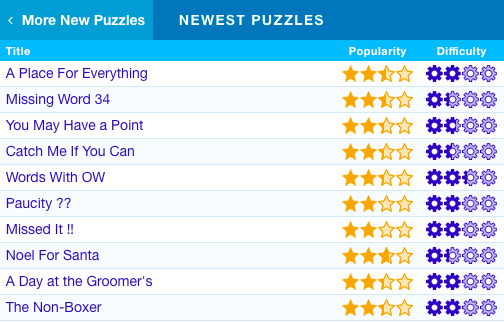
Join the 200,000+ members who keep their wits sharp with Braingle!
Braingle has a large vibrant community of smart people who contribute to the site in many ways. Some of the coolest features are only available to registered users. It's free to sign up, so why not give it a try?
Create a Free Account!
After creating your account, become a subscriber to get a number of added benefits.

Follow Braingle!
Get Your Free Braingle Account
- Submit your own brain teasers
- Vote on puzzles and track your favorites
- Chat with other smart people
Discover what your mind can do
Exercise memory, flexibility, and more with the world’s most popular brain training program..
No purchase necessary
You care about your brain. We do, too.
Train the skills that matter to you most.
Memory. Processing Speed. Problem Solving. Lumosity targets these cognitive skills and more.
Scientific rigor, made fun
Lumosity takes tasks from the lab and turns them into fun games. We interpret your scores to offer actionable feedback and rich insights into your cognition.
Daily exercise for your mind
Work out with a fresh set of games each day to keep you challenged. Detailed progress tracking helps maintain your brain training habit.
Brain training tailored to you
No matter your age or skill level, Lumosity knows that all brains are different, and our program adapts to your unique strengths and weaknesses.
Science. That feels like games.
Our scientists take tasks from the lab and adapt them into easy-to-learn brain games., 14 years, 100 million members.
4.7 rating on iOS App Store
"I am surprised and delighted by your games. I appreciate the variety and multiplicity of games and the feeling of personalization. The daily workouts are welcome, more fun than push ups, and they make my day go even better."
Mary , New Jersey
"I really like this app. Lots of great games and it comes with tutorials that help you understand the game. I love the Insights I receive every time I train. It's also nice that I get to choose what to play."
Rashmi , California
Researching the efficacy of Lumosity
What we did
Lumos Labs conducted a randomized study of Lumosity brain training and published the results in a peer-reviewed research journal.
In it, half of the 4,715 participants who completed the study trained five days per week, for fifteen minutes each day on Lumosity while the other half did online crossword puzzles as an active control.
What we found
After 10 weeks, Lumosity users improved more than the control group on our assessments of working memory, short term memory, processing speed, problem solving, fluid reasoning, and overall cognitive function.
These results are promising, but more research is needed to determine the connection between improved assessment scores and everyday tasks in participants' lives.
Next questions
Future research should address the risk of inadvertent experimenter bias and the risk of attrition bias in this study, as both the Lumosity and crossword groups had approximately 50% attrition rate. As with all scientific research, there is also a risk of publication bias.
Download Figment
Build a creative practice by experimenting with music, art, writing and more. download our newest app, figment, to jumpstart your creativity with new daily activities., introducing lumosity mind, lumosity mind includes mindfulness sessions on the topics of relaxation, focus, and sleep—designed by the experts at lumosity., start your free training program.
- Action Games
- Puzzle Games
- Mahjong Games
- Games forum

- Brain Games
- Number Games
- 0 Favorites
- Donate
Play the best free Mind Games online with brain, math, crossword and word games, sudokus and memory games. Visit our Puzzle Games site for more Puzzle games.
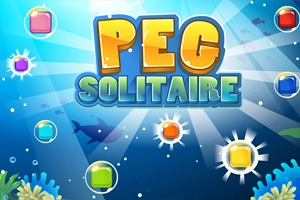
Peg Solitaire
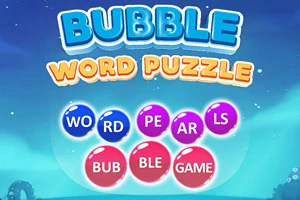
Bubble Word Puzzle
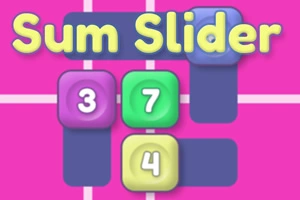
Tap it Away
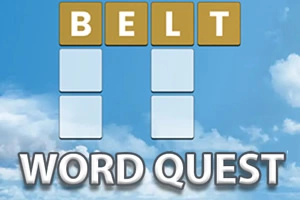
Daily Crossword
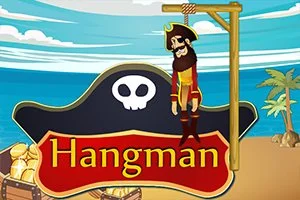
Daily Word Search
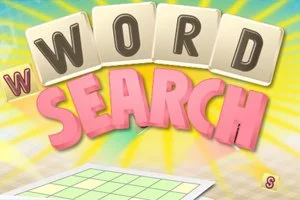
Word Search
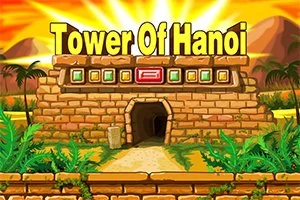
Tower of Hanoi
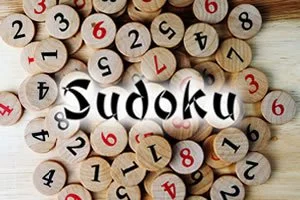
Daily Sudoku

The Daily Commuter Crossword

Daily Str8ts
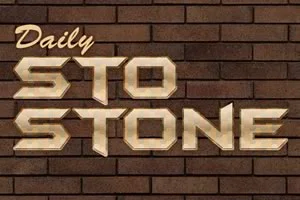
Daily StoStone

Sudoku Siege
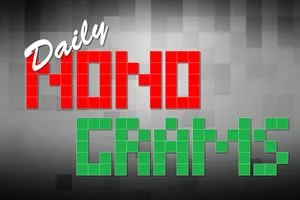
Daily Nonograms

Daily Suguru

Classic Word Wipe
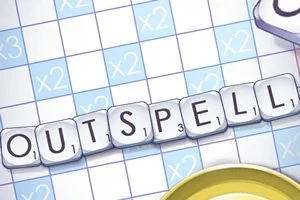
Daily Star Battle

Daily Same Game
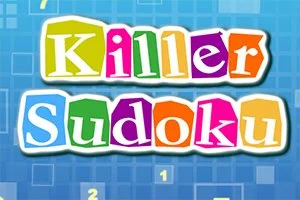
Killer Sudoku
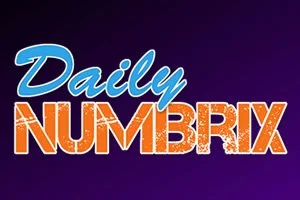
Daily Numbrix

Daily Futoshiki

Just Divide

Daily Shirokuro
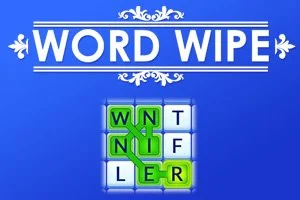
Daily Bridges
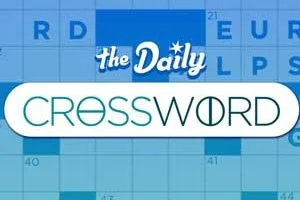
The Daily Crossword

Daily 1 to 25

Liquid Sort
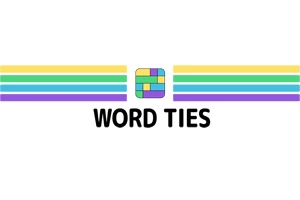
TextTwist 2
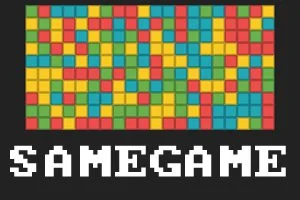
Scramble Words

Daily Tracks

Daily Sokoban
Our other sites….

- Skills by Standard
- Skills by Grade
- Skills by Category
Go to profile
- Assignments
Assessments
- Report Cards
- Our Teachers
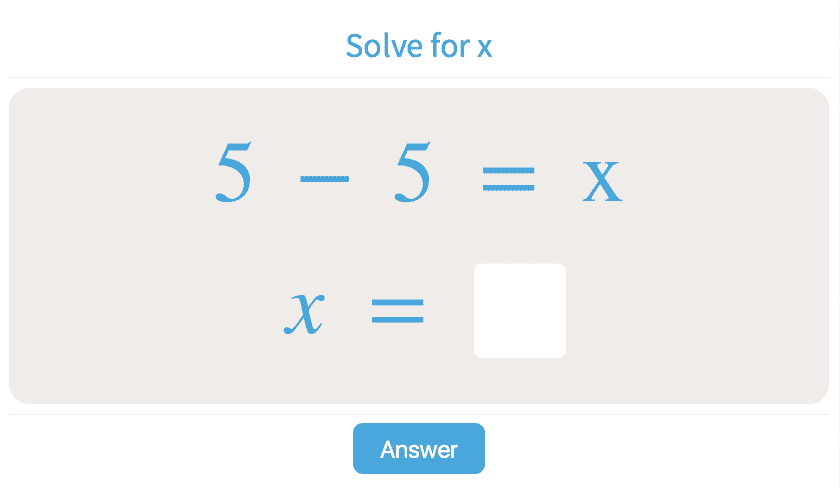
Common Core - State Standards Initiative
Algebra has a reputation for being difficult, but Math Games makes struggling with it a thing of the past. Kids can use our free, exciting games to play and compete with their friends as they progress in this subject!
Algebra concepts that pupils can work on here include:
- Solving and writing variable equations to find answers to real-world problems
- Writing, simplifying and evaluating variable expressions to figure out patterns and rules
- Solving linear equations and inequalities
- Finding the slopes of graphs, and graphing proportional relationships and equations
- Completing and writing rules for function tables
With Math Games, students can work at a suitable level for their individual abilities, in a format that’s simple to use and lots of fun to engage with! They can also use our digital textbook, game applications or PDF worksheets. Choose a skill to start playing.
Learn by doing
Guided interactive problem solving that’s effective and fun. master concepts in 15 minutes a day., data analysis, computer science, programming & ai, science & engineering, join over 10 million people learning on brilliant, over 50,000 5-star reviews on ios app store and google play.

Master concepts in 15 minutes a day
Whether you’re a complete beginner or ready to dive into machine learning and beyond, Brilliant makes it easy to level up fast with fun, bite-sized lessons.
Effective, hands-on learning
Visual, interactive lessons make concepts feel intuitive — so even complex ideas just click. Our real-time feedback and simple explanations make learning efficient.
Learn at your level
Students and professionals alike can hone dormant skills or learn new ones. Progress through lessons and challenges tailored to your level. Designed for ages 13 to 113.
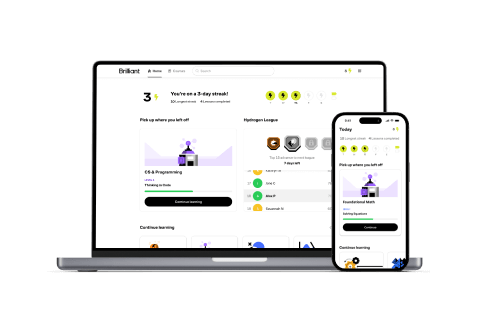
Guided bite-sized lessons
We make it easy to stay on track, see your progress, and build your problem solving skills one concept at a time.
Stay motivated
Form a real learning habit with fun content that’s always well-paced, game-like progress tracking, and friendly reminders.
Guided courses for every journey
All of our courses are crafted by award-winning teachers, researchers, and professionals from MIT, Caltech, Duke, Microsoft, Google, and more.
- Foundational Math
- Software Development
- Foundational Logic
- Data Science
- High School Math
- Engineering
- Statistics and Finance
Courses in Foundational Math
- Solving Equations
- Measurement
- Mathematical Fundamentals
- Reasoning with Algebra
- Functions and Quadratics

10k+ Ratings

60k+ Ratings
We use cookies to improve your experience on Brilliant. Learn more about our cookie policy and settings .
- Daily Games
- Strategy and Puzzles
- Vocabulary Games
- Junior Edition Games
- All problems
- MAML Problems
- Calculus Problems
- Loony Physics
- Pro Problems
- Getting Started
- Pro Control Panel
- Virtual Classroom
- Play My Favorites
- Select My Favorites
Problem Solving for Your Classroom
Yesterday's popular games, blogs on this site.
Our Games at Portland Proof

Recent Lesson Plans
Recent pro problems, ask professor puzzler, book scrounger, departments, welcome to the problem site, a site fueled by a passion to provide interesting, informative, and valuable content to educators and students. we have an enormous collection of math problems, physics problems, brain teasers, and puzzles written by educators. we also have a fine collection of educational games. these games aren't all fancy graphics and silliness; the focus is on the educational value for students, so those who play our games will get the most puzzling, problem solving, and learning, in a compact time frame. our games include word games, math games, strategy games, and even a handful of games specifically designed for young children. and if all that isn't enough, we also have printable mazes, worksheets, and vocabulary lists, and quizzes on a variety of subjects. the list of icons below will help you get started finding the resources you want., did you know....
The administrator of this site (AKA Professor Puzzler) is also a ventriloquist? You can see some of his work on youtube: Ventriloquist, teacher, song writer . Doug is also a math tutor and a music instructor.
Note: We are a participant in the Amazon Services LLC Associates Program, an affiliate advertising program designed to provide a means for us to earn fees by linking to Amazon.com and affiliated sites.

Tracking Health and Wellness Applications of Brain Science
Brain Teasers, Puzzles and Games for Teens and Adults

It is always good to learn more about our brains and to exercise them! .
Fun teasers on how our brains and minds work:

2. You say you can count? Check out this brief attention experiment
3. Test your stress level
4. Guess: Are there more connections in one human brain or leaves in the whole Amazon?
Challenge your cognitive abilities with these brain teaser games:
5. Quick brain teasers to flex two key mental muscles
6. Count the Fs in this sentence
7. Can you identify Apple’s logo?
Visual illusions:
8. Ten classic optical illusions to trick your mind
9. What do you see?
10. Fun Mental Rotation challenge
11. What is going on with these pictures?
Language and logic mind teasers:
12. Which way is the bus heading ?
13. Where do words go?
14. Join this party for polyglots
15. Fun & Brainy Haikus . Yours?
A few visual workouts to challenge your mind:
16. Is a circle a circle?
17. Less obvious than it may appear
18. How many…
How’s your pattern recognition?
19. Proverbs to exercise your memory and reasoning
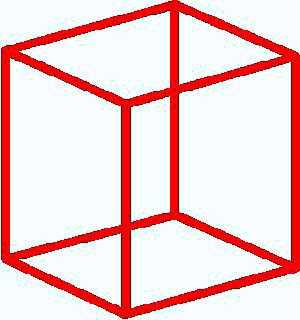
21. Good puzzle for the whole brain: The Blind Beggar
22. Find the the Really, Really, Really Big Number
Fun brain teasers for the workplace:

23. Please consider Linda ’s job prospects
24. A few guesstimations often used in consulting and tech interviews
25. How many golf balls can fit in a school bus?
What does it mean when you don’t see moving circles?
Leave a Reply Cancel reply

- MATH VIDEOS
- MATH WORKSHEETS
- MOBILE GAMES
- CHEAT SHEET
Search by Grade
Kindergarten
- Coloring Pages
- Fractions, Percentages and Decimals
- Most Popular
- Multiplication
- Probability
- Problem Solving
- Shapes and Geometry
- Subtraction
- Time and Money

- Math Videos
- Math Worksheets
- Math Cheat Sheet
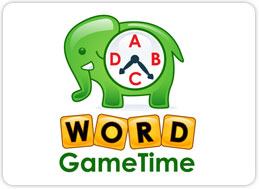
Problem Solving Games, Videos and Worksheets

- Bachelor’s Degrees
- Master’s Degrees
- Doctorate Degrees
- Certificate Programs
- Nursing Degrees
- Cybersecurity
- Human Services
- Science & Mathematics
- Communication
- Liberal Arts
- Social Sciences
- Computer Science
- Admissions Overview
- Tuition and Financial Aid
- Incoming Freshman and Graduate Students
- Transfer Students
- Military Students
- International Students
- Early Access Program
- About Maryville
- Our Faculty
- Our Approach
- Our History
- Accreditation
- Tales of the Brave
- Student Support Overview
- Online Learning Tools
- Infographics
Home / Online Bachelor’s Degree Programs / Online Bachelor’s in Liberal Studies Degree Program / Problem Solving Games
Problem Solving Games for Students
Problem-solving is an important skill to learn and work at. Every problem has a solution and there are skills you can practice in order to come to those solutions easily and quickly. Through critical thinking, logic, and consideration, you’ll be able to solve many problems every day. Use this collection of problem-solving links to help you practice your problem-solving skills specific to reading, math, puzzles, and more.
General Problem Solving
- Knowledge Adventure – Pick an exciting game that builds science, math, or word skills for students in preschool through sixth grade.
- Kaeru Jump – Can you make all the stones disappear by helping the frog hop on each one?
- FunBrain Junior – Build your brainpower while you play Beach Ball Balance, Beaker Bonanza, Deep Letter Dive, and lots of other fun games.
- Smarty Games – Choose from a variety of fun, educational games that challenge kids’ math, logic, and reading skills.
- Brain Den – Kids can challenge themselves to solve logic riddles, matchstick puzzles, and more.
- Topmarks Reading and Math Games – Kids ages 3-14 can choose from a variety of reading and math games that build their problem solving skills as they count sea creatures, spice up a scary story with adjectives, match animals to their sounds, and more.
Puzzles and Patterns
- Pattern Quest – Are you ready for a challenge? Put on your thinking cap and find the secret car pattern, one tricky clue at a time!
- Shape Sequences – Figure out which shape completes the pattern in this interactive, colorful game with fun sounds and animations.
- Pattern Matcher – Look at the silly pictures to discover their repeating patterns!
- Memorize Patterns – Memorize each pattern, but be quick! It’s your job to repeat it when it disappears.
- Pattern Games – Kids can learn to recognize patterns as they play a number sequence game or help a dog cross the pattern bridge.
Math Problems and Games
- Fast Math in Outer Space – You can solve math problems to shoot down enemy ships and win the space battle.
- Math Playground – Choose your math skill level from first through sixth grade and then race your pony in the Division Derby, compete in the Math Millionaire game show, play with the animals of Fraction Forest, and more!
- Math Zone – Want to learn about number lines with Cake Monster or win in MathCar Racing? Check out the Math Zone!
- Interactive Math Games – Improve your math skills with Monkey Drive, practice multiplication in Fruit Splat, or try the Animal Rescue Number Line.
- The Kidz Page – Try the Math Race or solve the Pirate Picture Math Puzzle!
Reading Games
- Alphabetter – Can you match each letter to the word it begins in this colorful, animated game?
- English Language Arts Games – Young readers with a range of ability levels can try the School Bus Spelling Game or play Sentence Spinner to add goofy adjectives to sentences.
- Greek Word Roots – Play the It’s Greek to Me game to strengthen your knowledge of Greek word roots as you represent your country in the Olympic Games.
- Starfall – Would you like to practice forming words and sentences while hearing them spoken aloud? Check out the cute, animated reading games at Starfall!
- Teach Your Monster to Read – Kids preschool age and beyond will love this engaging series of games that build reading skills. Whether children are learning letters and sounds or reading sentences, Teach Your Monster to Read can help them grow and thrive.
- ABC Countdown – Can you help the monkey practice his alphabet by picking coconuts in the right order?
- Room Recess – Use context clues to help Sir Readalot make his way through the castle or practice letter sounds with fun, animated characters.
Bring us your ambition and we’ll guide you along a personalized path to a quality education that’s designed to change your life.
Take Your Next Brave Step
Receive information about the benefits of our programs, the courses you'll take, and what you need to apply.
- Skip to content
- Skip to primary sidebar
- Skip to footer
unremot.com
Developer marketplace
Top 50 problem solving activities, games & puzzles for remote teams
Blockchain and Crypto / March 6, 2022 by admin
Here is a list of the top 50 problem solving activities, games & puzzles best suited for remote teams. Read on!
What are problem solving activities?
The success of a company or organization depends heavily on the managers’ ability to help workers develop their problem solving skills. Problem solving activities that address areas such as teamwork and cooperation, adaptability or reinforcement of decision-making strategies help.
All processes of problem solving begin with the identification of the problem. The team will then evaluate the possible course of action and select the best way to tackle it. This needs a profound understanding of your team and its core strengths.
Not only among corporates, but problem solving activities find their use in educational settings as well. Students who are good at solving problems will become much more successful than those who are not. Remote work and education are on the rise.
Enabling smooth interpersonal communication to solve problems can become a task in these situations. However, engaging all the people concerned in problem solving activities before shifting to the remote space can ease the process.
Also Read: Keen to invest in bitcoins – find a trustworthy bitcoin trader now!
Key skills evaluated in problem solving activities
Problem solving skills refer to the necessary thinking skills that an individual or group uses when met with a challenge. Many issues require the use of several skills; others are easy and may require only one or two skills. These are some skills that help to solve problems,
- Communication skills
- Decision-making skills
- Analytical thinking
- Negotiation skills
- Logical reasoning
- Persistence
- Lateral thinking
Problem solving skill examples
Several problems occur at the workplace. Problem solving skills can be technical problems that occur on websites or apps or addressing client concerns. Problems could be simple or complex. Business managers spend time and resources to solve problems.
They encourage their team to improve their analytical and logical abilities. Common issues in companies can be exploding data or changing technology, or financial management.
Did you know? Emotional intelligence plays a crucial role in problem solving!
Also Read: Keen to invest in Ethereum – find a trustworthy ETHtrader now!
Problem solving scenarios
Many problem solving scenarios occur at work. The basis to solve any problem is to evaluate and arrive at a solution. Analytical skill or problem solving ability is a skill many employers evaluate while hiring candidates.
Strong problem solving skills can be an asset to any organization. Organizations organize problem and solution activities to improve the problem solving abilities in the workplace.
1. Decision making games
Businesses are looking for new and innovative ways to stimulate their staff. Decision making games help employees to learn new skills and work effectively as a team. Decision making activities help to improve the creative problem solving and decision-making skills of the team. Here are some best Decision-making games,
1. Dumb Idea first – This game gives a hypothetical problem that could occur in your company. Ask each manager to think of the dumbest solution to the problem. After compiling the list of the ideas, the team reviews them.
You have a brainstorming session to make the “dumb ideas” feasible. This problem solving exercise underlines the importance of out-of-box thinking.
Benefits: Decision-making skill
Time duration: 10 to 15 minutes
Team size: 2 to more team managers
Material: Paper and pencil
2. Egg Drop Idea – The objective of the game is to build a container to protect the egg when dropped from a specified height using the material provided. Each team nominates a presenter who explains why the egg will survive the fall.
Once they have presented the idea, the team drops the egg to check if the idea has worked. Egg drop pyramid activities like the marshmallow challenge help teams to think on their feet.
Benefit: Decision-making skill and is a top problem solving skill example
Time duration: 15 – 30 minutes
Team size: 6 or more
Material: A cartoon of eggs, aprons to protect clothes, material for packing (cardboard, tape, elastics, plastic straws, etc.), material to clean up.
Instructions:
- Every team gets an egg and should choose from the building materials.
- Grant everyone 20-30 minutes to build an egg carrier and guard against breaking.
- Remove each egg carrier from a ledge (that is, over a balcony) to see which carrier prevents it from cracking.
- If several eggs survive, continue to heighten until only one egg remains.
3. Dog, Rice, and Chicken – The dog, rice, and chicken game can be fun decision-making activities for adults. In this game, one team member plays the farmer, and the other team members are villagers who advise him. The farmer has to take three items chicken, dog, and rice across the river by boat.
There are the following constraints:- only one item can be carried on the boat. He cannot leave the chicken and dog alone because the dog will eat the chicken. He cannot leave the chicken alone with the rice because the chicken will eat the rice grains.
Benefit: creative problem solving examples that are applicable at work.
Time duration: 10-15 minutes.
Also Read: Keen to invest in bitcoins – find a trustworthy bitcoin broker now!
2. Teambuilding puzzle
Team building exercises are fun and creative ways to get your team to work together and improve problem solving skills.
1. Lost at Sea – In this game, you and your friends have chattered a yacht to sail across the Atlantic Ocean. Since you do not have any navigation experience, you hire a captain and a two-person crew. Unfortunately, the crew and captain die when a fire breaks out on the yacht.
The yacht is severally damaged and is sinking. You and your friends have managed to save 15 items and a lifeboat. Your task is to rank the 15 items while you are waiting to be rescued. The activity lost at sea team building underlines the importance of problem solving skills in the workplace.
Benefits: Team building exercise and interaction
Time duration: 30 to 40 minutes
Team size: 4 to 6
Material: Lost in sea ranking for interaction chart for each member
2. Marshmallow Spaghetti Tower – The marshmallow team-building activities have the goal of building the tallest tower as quickly as possible. To make the task more challenging the marshmallow is placed at the top of the tower. This is a fun puzzle activity for team building.
Benefit: Teambuilding puzzle
Time duration: 30 minutes
Material required: 20 sticks on raw uncooked spaghetti, a marshmallow, masking thread, and yarn of thread.
3. Go for Gold – This is an example of a marshmallow challenge similar to activities. The objective of this exercise is to create a structure using pipes, rubber tubing, and cardboard to carry a marble from point A to point B using gravity.
Benefit: team building problem solving scenario examples
Team size: Minimum 6 persons
Material required: Each member has different material
Also Read: Keen to learn about bitcoins – find an experienced bitcoin consultant now!
3. Work Problem Solving
Work problem solving activities help to use the skills you used in problem solving activities in your workplace.
1. Create your own – this game aims to create a brand new problem solving activity for the organization. The team can brainstorm for 1 hour. After one hour each team has to give a presentation about their activity outlining the key benefits.
Benefit: Understanding the problem solving process. Build creativity, improve negotiation, and Decision-making skills
- When the participants arrive, you declare that they will create an original problem solving activity on their own, rather than spending an hour on an existing problem solving team-building exercise.
- Divide members into teams and encourage them to develop a new problem solving team-building exercise that will fit well with the organization. The activity should not be one they have engaged in or heard of before.
- Every team has to show their new activity to everyone else after an hour and outline the main benefits.
2. Shrinking Vessel – make a shape on the floor using a rope where all the team members can fit. Reduce the size every 10 -15 minutes. The real challenge for the team is figuring out how to work together and keep everyone together.
Benefits: Adaptability and cognitive diversity
Material: Rope and large room
- Place on the floor a big circle of rope. Position your whole team inside the circle.
- Lessen the circle size steadily. When it gets smaller, advise the team to keep the entire team inside the circle. Nobody must move out of the loop. See how small you can make the area until it cannot remain inside.
3. Legoman – the team is divided into groups of two or more people. Select an impartial individual who will make a structure in 10 minutes. Each team will compete to recreate it in fifteen minutes. Only one person is allowed to see the structure. They need to communicate vital parameters like color, shape, and size.
Benefits: Communication
Tools: Lego
4. What Would X Do – This problem solving activity stimulates teams to think of new ideas.
- Benefits: Instant problem solving
- Time Duration: 10-15 minutes
- Materials Required: N/A
- Let every team pretend to be someone famous.
- Every team needs to address the issue as if they were a famous person. Which are the choices they would consider? How will they do this?
- It helps all to consider options they may not have initially thought of.
Tip: Before you decide, a problem is worth solving, weigh the risks of solving it versus not solving it.
Also Read: Keen to invest in crypto – find the best crypto financial advisor now!
4. Team building riddles
Team building riddles are a great way to show the team group problem solving is usually more effective.
1. Barter puzzle – the team is broken into groups. Give each team a different jigsaw puzzle to solve. The groups have to complete the puzzle at the same time. The twist in the game is that some pieces of their puzzle belong to other puzzles.
The goal is to complete the puzzle before the other teams. Each group has to come with their method to convince other teams to handover the pieces they need, either by bartering pieces or donating time to the other teams. This puzzle piece team-building activity helps teams to collaborate.
Benefit: Team building and negotiating.
Material: Jigsaw puzzle for each team
Time: 30 minutes
2. Scavenger Hunt – in this game, each team has a list of the article to locate and bring back. The goal of the game is to finish the assigned list first. In the scavenger hunt, the team has a time limit to make the game more challenging. You have the flexibility of having the hunt outside or within the premises. The team-building puzzle game helps the team to look for creative solutions.
3. Escape – the goal is to solve clues and find the key to unlock the door in a limited time. Hide the key and a list of clues around the room. The team has 30 to 60 minutes to figure out the clues and unlock the door.
Benefit: Team building exercise
Material: Rope, key, lockable room, 5 to 10 puzzles
Also Read: Interested in crypto – find an expert crypto consultant now!

5. Work together problems
Work together on problems helps to underline the need to collaborate while solving issues at work. Group challenge activities help the team work well together.
1. Bonding belt – each group is divided into 5 to 6 participants, who are bound together with rope or tape so that their movements are limited. The team has to reach from point A to point B, and the time is recorded. The teams collaborate to beat their previous score.
Benefits: Helps the team to collaborate and skills for problem solving scenario/
Time: 20 to 30 minutes
Material: Cling film, belt, or rope
2. Scramble puzzle – the team members with blindfolds sit in a circle with the puzzle. The teammate without the blindfold sits outside the circle, with their back to the group. The blindfolded group tries to assemble the pieces of the puzzle. The outsider who has the same puzzle gives the team instructions to solve it.
Benefits: trust, leadership, and communication
Material: Preschool-level puzzles and blindfolds.
3. Flip it over – this is a classic work-together problem. In this game, 6 to 8 participants stand together on a blanket/towel/tarp. The challenge is to flip over the blanket or reverse it. The rule is that none of the participants can leave the blanket.
Benefit: Work together exercise
Duration: 30 minutes
Material: Blanket
Also Read: Building a blockchain – browse varied blockchain consulting services now!
6. Team building survival games
Team building survival games helps to fine-tune problem solving scenarios that may occur at work. The activities encourage creative problem solving and decision making.
1. Stranded – Stranded helps in building effective communication. In this setting, the team is stranded in an office. The rooms will be locked, and doors and windows cannot be broken down. The team is asked to make a list of 10 items that they need to survive.
They need to rank items in the order of their importance. The team has to agree on the items and the order. Stranded is one of several popular survival team-building exercises.
Benefit: Team building and Decision-making exercises
- Your team is stuck inside the building. Doors are closed, so there is no option to kick down the doors or smash the windows.
- Grant the team 30 minutes to determine what ten things they need to thrive in the office and list them in order of importance.
- The goal of the game is to get everyone to agree in 30 minutes about the ten things and their ranking.
2. Minefield – you randomly place items around the room or hallway and there is no clear path from one end of the room to another. The team is divided into pairs. One team member is blindfolded, and the other team member is the guide.
The guide navigates the blindfolded person across the minefield. The two partners cannot touch. This survival team-building activity underlines the need for clear communication.
Benefits: Communication and collaborative problem solving
Duration: 10-15 minutes
Material: Blindfold, empty room or hallway, and collection of random items.
3. Frostbite – in this survival scenario team-building exercise the team is trapped in Siberia. Each team has to elect a team captain. The team has to build a storm shelter with the material provided.
The twist in the game is the team captains cannot help physically since they have frostbite. Other team members are suffering snow blindness and are blindfolded. The electric fan will be turned on in 30 minutes to see if the shelter built will survive the storm.
Benefit: Leadership, skills action plan, and team building survival games
Team size: 4 to 5 members
Material: An electric fan, blindfold, simple building materials like cardboard paper, rubber bands, toothpicks, masking tape, straws, sticky notes, etc.
Also Read: Lost your bitcoins? Find a bitcoin recovery expert to retrieve it!
7. Group decision making games
Group decision making games help encourage creative problem solving and decision making at work. Here is a bunch of group decision making games
1. Reverse Pyramid – the team members stand in a pyramid shape. The next step is to flip the base and apex of the pyramid. The limiting factor in only three persons can move.
Benefits: Group Decision-making and collaboration
2. Tower of Hanoi – in this game, there are three towers/posts/rods with 5 or more discs arranged conical shape with the smallest shape at the top. The objective of the game is to move the entire stack to another location retaining the shape. Some conditions of the games are only one disc can be moved at a time. Only the top disc can be moved. Another rule of the game is larger disc cannot be put on a smaller disc.
Benefits: This team-building exercise helps problem solving within the participants.
3. Human Knot – the team stands in a circle every person holds hands with a person not standing next to them. When everyone is cross-connected, the aim is to untangle the structure without letting go of anybody’s hand.
Benefit: group problem solving
Also Read: Interested in crypto – find an expert digital asset investor now!
8. Funny problem solving games
We need to solve problems for personal and professional lives. Funny problem solving exercises are a light way. Funny problem solving can help reduce stress levels.
1. Pencil drop – in the pencil drop challenge, one end of the pencil is tied to a pencil and the other is tied around the waist of a team member. The other team member puts the pencil into the bottle placed below. The participants are not allowed to use their hands.
Benefit: Team bonding
Team size: 2 members each
Material: Some pencil and bottle
2. Blind drawing – this game requires two players to sit back to back. One participant describes an image in front of them without giving stating anything obvious. The other participant needs to draw it using the description. The outcome can be fun.
3. Be the character – in this activity, you pretend to be an imaginary character while trying to solve a problem. This game gives a unique perspective on your solution and whether the solution is feasible for other members.
Also Read: Keen to invest in crypto – find a trustworthy cryptocurrency consultant now!
9. Group problem solving activities for adults
Group problem solving activities are very efficient, especially for adults. These can be used in any setting to enhance problem solving skills.
1. Human Knots
- Benefits: Communication skills, collaboration
- Time Duration: 10 – 15 minutes.
This is one of the most straightforward group problem solving activities that can be done with any group. It facilitates communication and critical thinking in the face of a challenging and complex question. Various group members will possibly suggest a variety of solutions, and each will need to be reviewed and adopted by the organization as a whole.
- Have the group stand in a small circle (make several circles when you are a larger group). Every person in the loop will hold the hands of 2 other people who are not directly next to them. That would make a messy crossed arms knot.
- Ask the group to disentangle themselves without moving their hands at any point in time. They may be unable to disentangle completely to form a circle again. Still, they would have begun to work together to solve the problem by the end of the activity.
2. Frostbite
- Benefits: Leadership, decision-making, trust, adaptability
- Time Duration: 30 minutes.
- Materials Required: An electric fan, blindfold, simple building materials like cardboard paper, rubber bands, toothpicks, masking tape, straws, sticky notes, etc.
Your group is trapped in the barren deserts of Siberia, and a sudden winter storm is approaching. You have to create a shelter with only the materials in hand that can survive the storm’s harsh winds. The leader of your expedition was afflicted with frostbite in both hands, sadly, and all the others experience severe snow blindness.
- Divide the group into clusters of 4-5. Every group will have to elect a chief.
- Group leaders are not allowed to use their hands to support the group in any way, and group members should be blindfolded during the exercise.
- The groups have 30 minutes to build a small tent structure that can withstand the wind from the fan’s highest location.
3. Dumbest Idea First
- Benefits: Critical thinking, creative problem solving, quick problem solving
- Time Duration: 15 – 20 minutes
- Materials Required: Pen or pencil, a piece of paper.
Dumbest Idea First is one of the most creative problem solving activities for groups. This can encourage your creativity by thinking out of the box and lead you to ideas that would typically sound too insane to work. You can broaden the possibilities by looking at these crazy solutions first, and find potential alternatives that might not be as obvious.
- Present your team with a question. It could be a real-world dilemma facing the group, or it could be a created scenario. For example, your company attempts to beat a rival to win a high-paying customer contract, but the customer bends to your competitors. You have a short period before they make the final decision to change their mind.
- With the given question, advise your group to come up with the dumbest ideas to tackle the issue. Anything can be written down.
- After each person has put forward a few ideas, go through the list, and analyze each plan to see which are the most feasible. List them from the highest level of feasibility to the lowest level.
4. Wool Web
- Benefits: Leadership, communication
- Time Duration: 30 minutes
- Materials Required: Some balls of yarn.
As hard as replicating the magnitude of the real-world problems is, that is no excuse not to try! Wool web creates a dilemma that appears complicated at first, but groups will learn to break down complicated challenges into solvable problems one move at a time.
This happens by using the right strategy and working together. Undoubtedly, this is one of the most stimulating problem solving activities for adults.
- Split the group into similarly large teams. Every time, it receives a yarn ball.
- Tell each team to turn the yarn ball into a vast web. Give them around 5-10 minutes to do this. When done, rotate all the teams so that every team is on a yarn web they have not set up.
- Every group must choose one person to untangle the web. That individual would be blindfolded and be guided by the rest of the team on how to unwind the web using only verbal instructions. The first team to achieve it wins the game.
5. Tallest Tower
- Benefits: Creative thinking, collaboration
- Materials Required: 1 bag of marshmallows, one packet of uncooked spaghetti.
Simple building projects can help group members create strategies to overcome box issues. Tallest Tower is another one of the most creative problem solving activities. Groups will compete with only two materials to make the tallest tower in a fixed period.
- Divide the group into two, which have an equal number of players. Provide 20 – 30 uncooked spaghetti noodles and 3-4 marshmallows to every team.
- Groups must compete in the provided period to build the tallest tower using only the materials supplied. A marshmallow has to be set at the top of the tower.
Also Read: Struggling with blockchain – find an expert blockchain analyst now!
10. Problem solving activities for students
Below is a bunch of problem solving activities for students and kids,
1. Brainstorm Bonanza – Brainstorm Bonanza is one of the best problem solving activities for students. As a teacher, making your students create lists relevant to something you are teaching at the moment can be a fantastic way to help them expand their knowledge of a subject when learning to solve problems.
- Benefits: Problem solving
- Materials Required: Pen and paper
1. If you are discussing a real, current, or fictional occurrence that did not work out well, let your students imagine ways that the protagonist or participants might have produced a better, more favorable result.
2. They can brainstorm independently or in groups.
2. Clue Me In – this is one of the most enjoyable problem solving games. It facilitates logical thinking and cognitive development.
- Benefits: Cognitive development, logical thinking
- Time Duration: 20 minutes
- Materials Required: A bag, clues, items as necessary
- Select a collection of things relating to a specific occupation, social phenomenon, historical incident, object, etc.
- Assemble individual objects (or pictures of things) commonly linked to the target response.
- Place all of them in a bag (five-10 clues ought to be enough).
- Then, have a student reach into the bag and take out clues one by one.
- Select a minimum number of clues to draw before they make their first guess (two-three).
- After that, the student should guess, pulling each clue until they think it is right.
- See how quickly the student can solve the riddle.
3. Survivor Scenario – Create a hypothetical situation that allows students to think creatively to make it through. One example may be being stuck on an island, realizing that three days of help would not come.
The community has a small amount of food and water and has to establish shelter from the island’s objects. This would undoubtedly be one of the fascinating problem solving activities for students.
- Benefits: Logical thinking, collaboration
- Encourage working together as a group.
- Listen to each student who has an idea about making it safe and secure across the three days.
4. Moral Dilemmas – Create several potential moral dilemmas that your students can face in life, write down, and place each object in a bowl or container. These things may include items like, “I’ve seen a good friend of mine shoplifting. What is it that I would do?” or “The cashier gave me an additional $1.50 in change after I purchased candy from the shop. What is it that I would do?”
- Benefits: Logical thinking
- Time Duration: 5 minutes per student
- Materials Required: Container, bits of paper with moral dilemmas written
- Ask every student to draw an item from the bag one after the other and read it aloud.
- They must then tell the class the response on the spot as to how they would handle the situation.
5. Problem solving box – this is an activity that will help on both cognitive and emotional levels for students.
- Benefits: Logical thinking, decision making
- Materials Required: Box, paper, pen
- Have your students design and decorate a medium-sized box with a top slot. Name it as the “Problem Solving Box.”
- Invite students to write down anonymously and apply any concerns or problems they may have at school or at home, which they do not appear to be able to work out on their own.
- Let a student draw one of the things from the box once or twice a week, and read it aloud.
- Finally, as a group, let the class work out the best way students can approach the problem and eventually solve it.
Also Read: Invest large in bitcoins – get a profitable deal from a bitcoin OTC broker now!
11. Problem solving activities for kids
Below is a bunch of problem solving activities for kids,
1. Puzzle-solving – Solving puzzles is one of the best problem solving activities for kids out there. Essentially, every puzzle is a big collection of muddled-up items to figure out and bring back together again.
Kids must be introduced to puzzles with regularity. These are useful for improving skills in reasoning. The best kinds to choose from are wooden puzzles with a wooden frame. They last long, and the structure serves as the foundation to direct children during construction.
- Benefits: Reasoning skills
- Time Duration: Varies
- Materials Required: Puzzles according to the age level
Instructions:
- Show the kids a demo of how a particular puzzle can be solved.
- Then, let them choose a puzzle of their liking from the available choices.
- Ask them to solve their chosen puzzles.
2. Memory Games – Memory games will improve memory and attention to detail for your child.
- Benefits: Attention to detail
- Materials Required: Matching pairs of images
- Using matching pairs of images and turn them all face down, shuffled, on a table.
- Take turns to pick any two cards, and face them on the table.
- You hold the cards if you turn over a similar pair, and if the pair does not match, turn the cards over before it is your turn to try again.
- A teacher/parent must encourage the kids to concentrate on where the pictures are, and seek to find a matching pair on each turn.
3. Building games – Construction toys like building blocks, wooden blocks, or legos should be a staple in a kid’s home every day. Playing with them is one of the most fun problem solving activities for kids. Anything that your child builds is a challenge as it involves thinking about what to create and how to put together the parts to get a workable and usable design.
- Benefits: Decision making
- Materials Required: Construction toys.
1. Let your child build a challenge openly and often, and ask him/her to build a particular structure, with conditions. For instance:
- Create two towers with a bridge that connects them.
- Create a creature that stands alone and has three arms.
2. Observe how your child uses trial-and-error before finding a way to bring the idea into motion.
4. Tic-Tac-Toe – this is an excellent game for teaching decision-making skills. It encourages kids to think before they act and weigh the potential consequences.
- Materials Required: Pencil, paper
- Draw a simple tic-tac-toe table on paper or chalkboard.
- Take turns to add a nought or a cross to the table to see who is the first to make a line of three.
- Your kid will likely catch on in no time before placing their symbol and start thinking carefully.
- Coloured counters or different items can be used to play this game as well.
5. Building a Maze – This activity is fun and fits for any age. It will also be a lot more enjoyable than doing a maze in an activity book, particularly for younger kids.
- Materials Required: Chalk
- Draw a big maze with jumbo chalk on the paving. Make passages, including one or two, which end in an impasse. Teach your kid how to get out of it.
- Make the maze more complicated and add more dead-end passages as your child gets better at figuring out a path and finding the way out.
Also Read: Developing a blockchain – hire an expert blockchain developer now!
What is a problem solving process?
When a team or person faces an issue or obstacle, it can be tempting to quickly track a potential solution and set up a fast fix. This could happen without understanding the complexity of the problem and pursuing a systematic approach to seeking a solution.
The attempts to address issues or obstacles may become unstructured and frustrating without a consistent method. End-to-end processes for problem solving offer a mechanism for a community to tackle any size or nature, and see results. Problem solving activities for adults, kids, and students can help make the problem solving process very useful.
Army problem solving process
There are 7 steps to problem solving army model,
- Recognize and define the problem – The first step army problem solving process is defining the problem precisely and determining the root cause.
- Gather facts and make assumptions – You need to gather all information you have at your disposal. Common resources for information may be documentation and policies. Assumptions are unsubstantiated facts. Use facts rather than assumptions when you need to analyze the scope of the problem.
- Generate alternatives – One of the key steps in military problem solving is finding ways to solve the problem. Ideally, it best to have multiple approaches to solve the problem. Take input from peers and subordinates if possible.
- Analyze possible solutions – Analyze each possible solution with advantages and disadvantages. You evaluate each solution according to screening and feasibility criteria. Reject the solution when it fails in the screening process.
- Compare Alternatives – Another crucial step in the army problem solving model is to evaluate alternatives for cost and benefits. You need to consider your experience and immediate future. Tabulating each solution with the pros and cons will help clear the picture.
- Make an executive your decision – Make a decision and prepare an action plan, and put it in motion.
- Assess the result – You need to monitor the implementation of the plan and modify it if required. Establishing critical steps and milestones will help to ensure success.
Army problem solving games
- Capture the flag – the game helps in team building and army problem solving. Two teams compete against one another to retrieve a flag or object from the opposing team camp base and get into their camp base. This game is flexible, and ground rules need to be set before the game starts.
- Paintball – Paintball is a fun military problem solving activity. You can have many modifications and variations of the paintball game. The aim is to fire paint pellets at the opposing team. Laser tag is another variation of the game.
- Firing blind – Firing blind is a game where each team has a large number of water balloons. At the other end of the field has to hit the target is protected by a tarp from direct firing. The team has to hit the target that is covered. One team member acts as the observer and directs the team to hit the target with the water balloons.
Also Read: Interested in NFT – find an expert NFT consultant now!
Obstacles to problem solving
Problem solving can take time and patience, one of the best ways to solve any problem is pausing and evaluating the problem. Obstacles to problem solving are,
- Misdiagnosis – Misdiagnosis is a common problem can occur due to preconceived idea, biases or judgments. Defining and having a concrete understanding of the problem is the first step in the problem solving activity. This can be difficult. If you are not careful, you may spend your time and resources solving the wrong problem and finding the wrong solution.
- Communication bias – Communication barriers are caused when we are unable to explain the problem to the team, or presuming we know more than everyone else. Everyone on the team must be on the same page. You may need to acknowledge you have a limited understanding of the problem.
- Solution bias – A common obstacle in problem solving is thinking there may be a universal solution or thinking the same solution can solve multiple problems. You need to evaluate a problem independently than try to force-fit a solution that worked previously.
- Cognitive bias – One of the barriers to finding an effective solution is cognitive bias, or the tendency to jump to conclusions. To find solutions fast firms often end up with an irrelevant solution. This may cause more problems down the line.
- Lack of empathy – Every problem is associated with human emotions or abilities. It is important to identify and recognize people affected by the problem or it will be difficult to find a solution that will solve help.
Also Read: Developing an NFT – hire an expert NFT developer now!
Famous virtual problem solving software
Traditionally watercoolers chat is a great way to bring people together and help team members interact with one another. A virtual water cooler has a similar concept where people interact in a similar virtual setting or a dedicated virtual room. It allows remote teams to bond. Software that offers virtual water coolers services,
- unremot.com – provides users with a unique water cooler experience. The app provides unique solutions to remote teams.
- Microsoft Teams
- Informal Whatsapp group
- Donut over slack channels
Blockchain & Crypto

Best Crypto Trading Tools You Need to Know About
It's 2023, and crypto trading is still waxing strong, getting more popular as the day passes. …
Continue Reading about Best Crypto Trading Tools You Need to Know About

Decoding the Layers: Simplifying Crypto Wallet Security
In this article, we will delve deep into the intricacies of crypto wallet security and provide …
Continue Reading about Decoding the Layers: Simplifying Crypto Wallet Security

Uniswap: A Decentralized Exchange Protocol for Ethereum Tokens
In this article, we will explore what Uniswap is, how it works, and why it has become so …
Continue Reading about Uniswap: A Decentralized Exchange Protocol for Ethereum Tokens
Background checks in less than 30 minutes!
Get the background checks completed for anyone in less than 30 minutes. Just enter the email ID and press start verification!
Tales of Soldiers and Civilians, By Ambrose Bierce

Why do you need unchek?
Instant background check on anyone | Generate reports in 30 minutes | Run checks on anyone with an email | Completely free and online | Includes professional and educational checks | Covers social and personal insights
Don't have a personal office yet?
Nurture healthy conversations at your office with 360-degree virtual experiences of your real-office water coolers, cafeterias, and game zones!
...it’s not nice to talk about people behind their backs, but that’s not to say that gossip doesn’t have any social value. In fact, it has plenty. Gossip is the foundation of our species’ survival...
Sapiens: A Brief History of Humankind, by Yuval Noah Harari
Select from many spaces.
Cafeteria | Watercoolers | Virtual Gym Game Zone | Conference Rooms | Virtual Spa Ping-pong Tables | Fun Zone | Office Rooms and more...
Top 22 Virtual Problem-Solving Activities to Strengthen Any Team
We live in a fast-paced environment where challenges often arise, both personally and professionally.
Especially in today’s workplace, professionals have to deal with social, ethical, and organisational problems.
This is where problem-solving skills come into play.
Strong problem-solving tactics can improve creativity and help team members make efficient and informed decisions.
While every professional might not be a natural born problem-solver, there are a lot of resources to help develop these skills.
In this article, we’ll go over the definition of problem-solving activities, their main benefits, and examples that can be put into practice in the workplace.
What Are Problem-Solving Activities?

These activities require problem-solving skills, which help find solutions for difficult situations.
Like any other skill, these tactics are best learnt through practice.
To make problem-solving activities worth the ride, participants have to be open-minded, listen to others, and accept alternative ideas and solutions.
An agile mindset can also be beneficial when participating in such activities because they’re based on understanding, collaborating , learning and staying flexible.
As problem-solving games are group activities, participants must be willing to collaborate and embrace agility and flexibility.
Another critical aspect is creating the mindset that there are no winners or losers.
The goal of these activities is to share strategies and learn from each other, rather than compete against one another.
The Four P’s to Problem-Solving
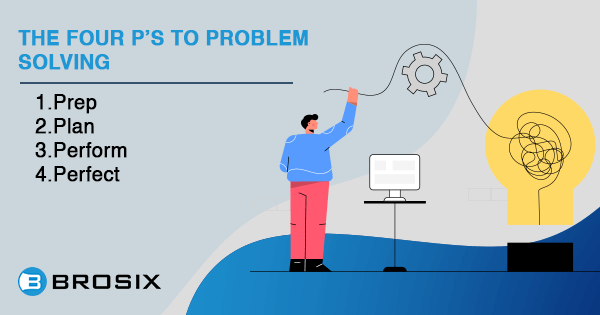
By following the four P’s in the problem-solving guide, one can resolve almost any problem that comes along.
Problem-solving activities begin with a discovery phase, where the problem is identified.
This is the step where you understand, dissect, and learn about the problem you’re trying to solve.
Until the problem has been well defined, you can’t move forward and prepare to form the right solution.
After you’ve analysed the problem, you have to develop several courses of action to solve the issue.
This is the phase where you generate several possibilities to ultimately decide on the best course of action for your problem.
After the problem has been defined and resolutions have been listed, it’s time to take action.
This is the step where you find the best approach and implement a plan that needs to be followed with precision.
You need to first visualise your plan and then execute it.
When the problem has been solved, you need to evaluate the plan and assess whether it could be improved for future situations.
While you should do your best to solve the issue, the truth is that there is always room for growth.
Reviewing and checking for room for further improvement is essential because it can help you achieve even greater results in the future.
Benefits of Developing Problem-Solving Skills in the Workplace

Employees are often asked to think outside the box for projects or find alternative solutions for work problems.
Problem-solving tactics are a great way to practice valuable skills relevant in the workplace.
There are a lot of situations where processes and workflow in organisations need improvement. Or, when deadlines are tight, team members have to find ways to deliver on time.
These are the exact scenarios that can be overcome if the team is able to turn problems into actionable solutions.
After all, performance is closely related to employee efficiency as achieving companies’ goals on time is crucial to success.
Having team members with good problem-solving skills means they can use critical thinking to make better decisions and ultimately increase business productivity and growth.
There are a wealth of advantages that problem-solving activities can bring to teams.
Here are a few benefits you can expect from employees well equipped with problem-solving skills:
Better risk management
Simply put, risk management skills help people know what could go wrong, assess risks, and finally take action to solve an issue.
Some people are very good at handling risk, while others are afraid of risky situations.
Whichever way your team members are naturally inclined, problem-solving techniques are here to help.
Participating in problem-solving tasks trains the mind to handle stressful situations better.
It’s impossible to avoid risk, and this is why it’s essential to be confident that your team knows how to handle risk and turn it into opportunity.
Better thinking
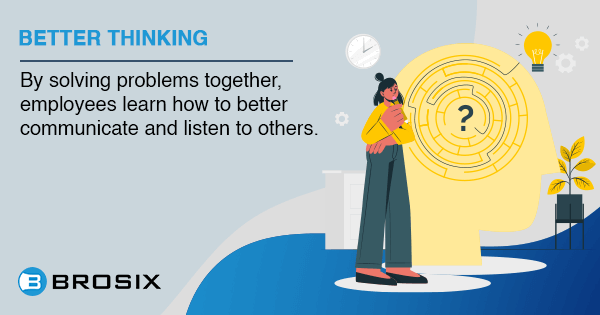
Team problem-solving techniques stimulate better thinking by pushing people to find progressive alternatives.
Better thinking also develops analytical skills, which help people find logical explanations for problems and identify practical solutions.
Better communication skills
As mentioned earlier, problem-solving activities are group tasks that can only be performed if participants work together.
Humans are competitive by nature which can be problematic when trying to create a cohesive team. Problem-solving skills nurture understanding and collaboration within a company.
By solving problems together, employees learn how to better communicate and listen to others.
Having transparent and effective communication improves engagement and productivity and leads to better relationships .
Increased team cohesion
If your team already has good communication skills , this will likely lead to increased team cohesion .
Regardless of your business’s profile or size, success comes from having a united team.
Team cohesion reduces anxiety, brings motivation, and increases employee satisfaction.
Being on a cohesive team means that employees work together for the same goal, and everyone contributes to the group’s overall success.
People are social creatures, so it’s imperative that everybody feels heard, understood, and included.
Efficiency / increased productivity
Exercising problem-solving activities can boost performance and workplace productivity, leading to overall growth and profits.
Having solid problem-solving skills equips employees with the ability to find efficient solutions promptly.
By reducing the time spent solving specific problems, companies benefit from improved workplace productivity , leading to better profit margins.

Problem-solving activities foster creativity and encourage team members to express their ideas.
Creative thinkers know how to find the balance between analytical skills and innovative solutions, thus providing new perspectives.
No matter how well-established company processes are, there are always situations that require alternative ways of thinking.
Creative thinking skills boost people’s confidence in putting forth unique ideas.
List of the Top 22 Virtual Problem-Solving Activities
Virtual problem-solving activities for teams are meant to challenge participants to think outside the box and find solutions to problems while also having fun. Remember that these exercises should be playful and enjoyable.
Here is a list of virtual problem-solving activities that teams of any size can play:
- Dumbest Idea First
- Brainstorm Ideas
- End in Mind
- Stop, Start, Continue
- Idea Mock-Ups
- Be a Character
- Crossword Puzzles
- Online Escape Rooms
- Murder Mysteries
- Virtual Hackathons
- Treasure Hunts
- Moral Challenge
- Improv Games
- Poem/Story Challenge
- What Would You Do?
- Lost at Sea
- Coworker Feud
- Virtual Code Break
- War of the Wizards
- Ultimate Game Show
Online problem-solving activities can be played through video conferencing platforms, such as Zoom, Skype, Google Meet, Webex, etc.
Let’s take a closer look:
1. Dumbest Idea First
Dumbest Idea First, as the name suggests, is a problem-solving exercise in which participants are asked to think of the dumbest possible solutions to the problem presented.
After all ideas have been presented, look through the list.
You might be surprised to find that some ideas are not as dumb as first thought!
Helps with : creative problem-solving .
2. Brainstorm Ideas
One of the most common problem-solving activities is brainstorming ideas with your team.
Brainstorming ideas’ objective is to generate as many ideas as possible.
After the list is complete, team members review them and decide which is most suitable for the given scenario.
There are a lot of methods to aid the brainstorming process.
You can play word games, create a mood board, play improv games, or even doodle.
Helps with : lateral thinking.
3. End in Mind
The End in Mind technique is an excellent activity for solving group problems that require participants to start with the end.
In this exercise, you have to backtrack, finding solutions for the issue.
It challenges team members to think of the “what,” “why,” and “how” of a problem, thus coming up with alternative approaches.
Helps with : analytical thinking.
4. Stop, Start, Continue
“Stop, Start, Continue” is a technique used for delivering or requesting feedback.
This problem-solving activity consists of a list of three categories that each member has to think about:
- Stop: three things that the team should stop doing
- Start: three things that the team should start doing
- Continue: three things that the team should continue doing
This exercise aims to solve problems in new ways while also having fun.
Helps with : team cohesion, critical thinking.
5. Idea Mock-Ups
Idea mock-ups are processes in which solutions to problems are found via mock-ups.
It’s a virtual solving problem activity as you can use images from the internet that can be easily shared with the team members.
This exercise aims to have players try out a bunch of different scenarios until the perfect match for the problem is found.
6. Be a Character
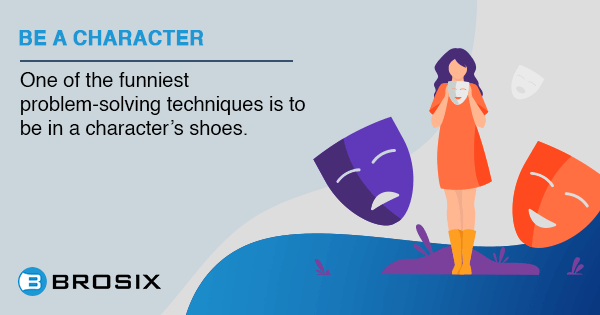
Have you ever dreamed of being a character from a movie or a book? Then this is the perfect exercise for you.
By playing this group game, participants impersonate a character and approach problems through that person’s mindset.
Helps with : creativity , thinking outside the box.
7. Idea Trial
The Idea Trial is another fun virtual problem-solving activity that encourages participants to find solutions for a particular problem.
Players need to present their ideas to the “court.”
They can go through the entire process, such as opening and closing statements, and call witnesses to support their ideas.
Helps with : risk management, communication skills.
8. Crossword Puzzles
Everybody has heard of crossword puzzles, but not everyone has thought of transforming them into a virtual problem-solving activity.
All you have to do is use an online crossword puzzle to create a custom puzzle for your team.
To make it more exciting and engaging for your team, you should consider your company’s niche and your teammates’ interests.
Helps with : critical thinking.
9. Online Escape Rooms
Like in-person escape rooms, their online counterpart requires participants to escape rooms and work together to solve puzzles virtually.
Digital escape rooms provide two alternatives for players: either a Zoom room led by a host or from a specialised website.
These are significant virtual problem-solving activities that are both fun and challenging.
Helps with : cooperation, communication.
10. Murder Mysteries
Murder mysteries are story-based problem-solving activities that require participants to take on the roles of suspects and detectives.
The aim of the game is to identify the killer by searching for clues and occasionally solving small puzzles.
These group exercises are complex because they require players to be observant and search for hidden clues using logic.
Luckily for you, there are many options for playing murder mystery games online .
Helps with : observation, logical thinking.
11. Virtual Hackathons
Hackathons are events where a group of people pitch a product or service in a given period.
Even though it originated in the programming world, hackathons can be easily applied to any industry.
Virtual hackathons refer to the online version of these events, where participants work together via online meeting software to design solutions.
These are great virtual team problem-solving activities because they don’t require much organisational work.
You just have to announce the event’s theme, explain the problem when the hackathon begins, and set a timeline.
Helps with : efficiency, cooperation.
12. Treasure Hunts
Like escape rooms or murder mysteries, treasure hunts are group games that require players to find hidden objects by following a trail of clues.
Treasure hunts are fun problem-solving activities that teach participants how to collaborate and communicate with each other.
They can have specific themes or be a more general hunt.
Helps with : communication, cooperation.
13. Moral Challenge
While most group problem-solving activities focus more on finding alternative problem resolutions, moral challenges lean more towards ethics.
These group techniques are just as important as the others as not all problems are factual; some are ethical.
Moral challenge exercises are better played in a group because each participant can represent a different opinion or moral belief.
The moral issue becomes harder to resolve and implicitly forces team members to find common ground.
Moral challenges are equally important in decision-making processes as rational thinking.
Some of the most well-known moral challenges online are the Moral Machine or the Dilemma .
Helps with : communication skills.
14. Improv Games
Improv games have their roots in acting and comedy and are group activities designed around participants’ acting without a script, or improvising.
These problem-solving activities force players to keep the story going in an entertaining and logical way.
This kind of group exercise helps build collaborative skills while boosting team members’ confidence.
Helps with : collaboration, imagination.
15. Poem/Story Challenge
If most of the problem-solving activities mentioned are based on logical thinking, the poem/story challenge revolves around writing skills.
While not all businesses rely on this, it’s still an excellent exercise for groups, as it stimulates the imagination and improves public speaking.
All you have to do is ask participants to create a story or a poem using a limited word bank.
After they have crafted their stories, they read them aloud in front of the group.
Helps with : creativity, public speaking.
16. What Would You Do?
“What Would You Do?” is a hypothetical problem-solving activity that challenges your team to brainstorm ideas and react to different scenarios.
To play this game with your team members, prepare some problem-solving stories in advance, then read them one by one.
Participants have to say what they would do in these circumstances.
Helps with : lateral thinking, imagination.
17. Lost at Sea
Lost at Sea, also known as Stranded at Sea, is a team-building activity that encourages interaction and teamwork.
Give participants a scenario where they’re stranded on an island with just a handful of objects.
To increase their chances of survival, they need to rate the objects based on their utility.
Players should work individually first and then together to decide which objects are most important.
If multiple groups play this game, the moderator can ask each group to compare their individual and collective rankings.
They should also consider why any scores differ.
At the end of the game, players reflect and feedback on their choices.
Helps with : decision making, collaboration, critical thinking.
18. The Hunt
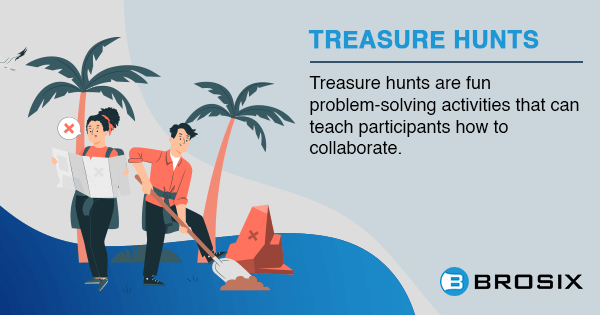
Its purpose is to challenge players to collaborate under pressure as they compete for glory.
This is a virtual problem-solving activity suitable for a business of any size.
It works best played in small teams of four or five, so players have the opportunity to interact with one another.
Helps with : team decision making, lateral thinking, creativity.
19. Coworker Feud
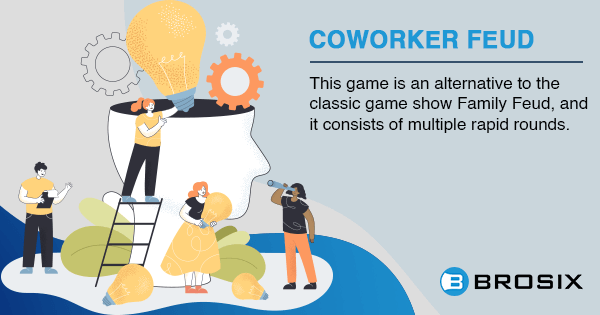
This game is a new take on the classic game show Family Feud, and it consists of multiple rapid rounds.
The players are asked to provide fast answers to a fun assortment of questions the host presents.
The aim is to guess the five most popular answers to win points for the round.
The team with the most points is declared the winner of the game.
Helps with : fast-thinking, communication.
20. Virtual Code Break
Virtual Code Break is a virtual team-building activity specially designed for remote players.
Its purpose is to challenge players to think outside the box, improve problem-solving skills, and leverage their own and each other’s skills.
This game uses an intelligent video conferencing solution so that teams of all sizes can play from anywhere globally.
Players compete against each other by answering trivia questions and solving riddles and puzzles.
Helps with : better thinking, collaboration.
21. War of the Wizards
War of the Wizards is a 90-minutes virtual team-building activity that promises to be both fun and creative.
To play this game, participants roleplay as powerful wizards to conquer evil forces through the power of storytelling.
They have to play mini-games and competitions, develop their characters, and make decisions together to win.
Helps with : teamwork, imagination.
22. Ultimate Game Show
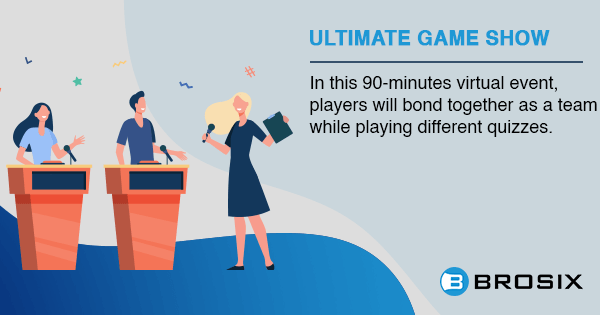
In this 90-minute virtual event, players bond together as a team while playing different quizzes to win the final prize.
This competition works for hybrid teams, as well as for fully remote teams.
Helps with : collaboration, fast-thinking.
Plenty of organisations face daily challenges that affect team productivity and get in the way of attaining business goals.
While it’s impossible to avoid those situations, there are many ways to train team members to work collaboratively to resolve problems effectively.
Problem-solving activities act as educational tools that bring all participants closer as a team and help them develop problem-solving skills. By nurturing solution-generating capabilities, your team learns to communicate better, act fast in risky situations, and find creative solutions.
The virtual problem-solving activities listed in this article are excellent practices for real-life conflict resolution that can benefit everyone within an organisation.
Stefan is a Co-Founder and a President of Brosix. His many years experience as a programmer, give him an unique perspective to lead the team and build Brosix in a way to best serve the customers.
You may also like

9 Simple Ways to Increase Team Productivity in the Workplace

60+ Productivity Quotes to Keep You Motivated to Conquer a New Workday
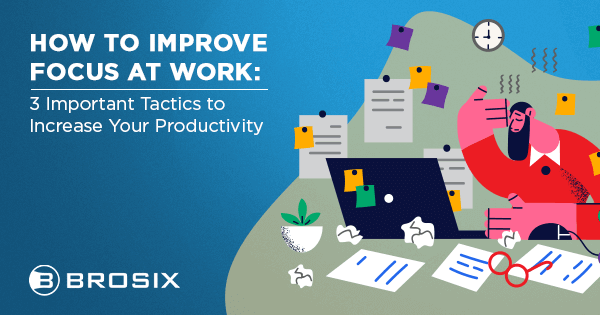
How to Improve Focus at Work: 3 Important Tactics to Increase Your Productivity
Code breaker deluxe.
Human validation
Touchscreen
Are you ready for a game that will put your problem-solving skills to the test? Then look no further than Code Breaker Deluxe, the ultimate master in mind game that will challenge you like never before! With its sleek design and intuitive interface, Code Breaker Deluxe is the perfect choice for gamers of all levels. Whether you're a seasoned master in mind enthusiast or a newcomer to the genre, our game is sure to provide hours of entertainment and endless fun. Enjoy playing this game here at Y8.com!
Please register or login to post a comment
My Perfect Organization
Pick and Go!
Bubble Truck
Space Arcade
Desktop Only
Mini Truck Driver

Battle Maidens
Hexa Jigsaw Puzzle
Criss Cross Colors
Blood of Vladula Jr.
Egg Hunt Mania
Solitaire Klondike
Playing with Fire 2
Parkour Block 5
Push the Colors
Alfie the Werewolf: Soup Adventure
Redemption Slot Machine
Arena Crash
Bubble Shooter Pro 3
Jumpy Helix
Ball Fall 3D
Fireboy And Watergirl Light Temple
Four Colors
Count Expert
Your browser is not supported. Please upgrade your browser to one of our supported browsers . You can try viewing the page, but expect functionality to be broken.
Computer Science Fundamentals
Free set of elementary curricula that introduces students to the foundational concepts of computer science and challenges them to explore how computing and technology can impact the world.
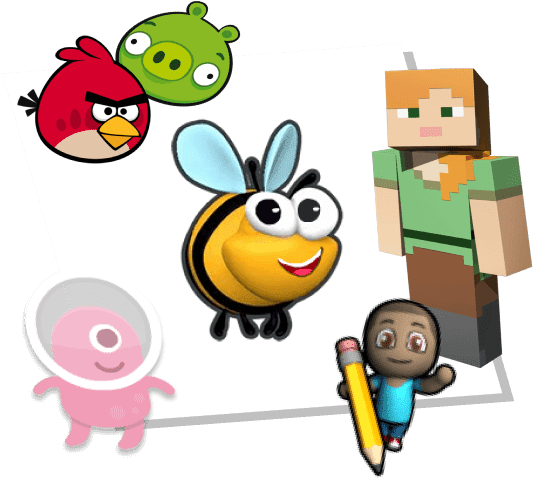
Free, and fun, elementary courses for each grade
- Six courses, one for each elementary grade
- Equitable introductory CS courses
- Use the same course for all students in the same grade, regardless of their experience
- All courses make suitable entry points for students
Curricula at a glance
Grades: K-5
Level: Beginner
Duration: Month or Quarter
Devices: Laptop, Chromebook, Tablet
Topics: Programming, Internet, Games and Animation, Art and Design, App Design
Programming Tools: Sprite Lab, Play Lab
Professional Learning: Facilitator-led Workshops, Self-paced Modules
Accessibility: Text-to-speech, Closed captioning, Immersive reader
Languages Supported: Arabic, Bahasa Indonesian, Catalán, Chinese Simplified, Chinese Traditional, Czech, French, German, Hindi, Italian, Japanese, Korean, Kannada, Malay, Marathi, Mongolian, Polish, Portuguese-BR, Romanian, Russian, Slovak, Tagalog, Tamil, Thai, Turkish, Ukrainian, Spanish Latam, Urdu, Spanish-ES, Uzbek, Vietnamese
I've been teaching the course since the Monday after the workshop. The students and I LOVE it (and so do their classroom teachers!!!)
CS Fundamentals Teacher
Picking the right CS Fundamentals course for your classroom
With the diverse set of options offered for CS Fundamentals, there is a course for all different needs.
How will your students engage with the content?
Courses specifically designed for your elementary classroom.
Find the course for the grade you teach. Each course is approximately a month long.

Program using commands like loops and events. Teach students to collaborate with others, investigate different problem-solving techniques, persist in the face of challenging tasks, and learn about internet safety.
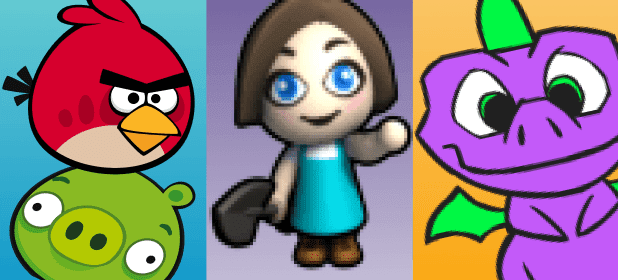
Through unplugged activities and a variety of puzzles, students will learn the basics of programming, collaboration techniques, investigation and critical thinking skills, persistence in the face of difficulty, and internet safety.
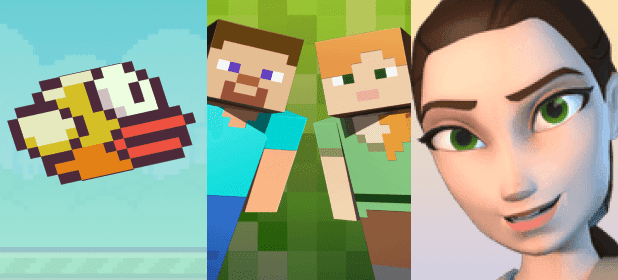
Create programs with sequencing, loops, and events. Investigate problem-solving techniques and develop strategies for building positive communities both online and offline. Create interactive games that students can share.

Review of the concepts found in earlier courses, including loops and events. Afterward, students will develop their understanding of algorithms, nested loops, while loops, conditionals, and more.

Make fun, interactive projects that reinforce learning about online safety. Engage in more complex coding such as nested loops, functions, and conditionals.

Look at how users make choices in the apps they use. Make a variety of Sprite Lab apps that also offer choices for the user. Learn more advanced concepts, including variables and “for” loops.
Self-paced elementary curriculums
Teachers play a critical role in student learning by teaching our unplugged activities and leading whole class discussions, however, we recognize that CS Fundamentals isn't always taught in a traditional classroom setting. We provide two self-paced express courses alongside Courses A-F. These express courses are designed for situations where teachers allow each student to work at their own pace independently.
Grades: K-1
Pre-Reader Express

Learn the basics of drag-and-drop block coding by solving puzzles and creating animated scenes. Make art and simple games to share with friends, family, and teachers.
Grades: 2-5
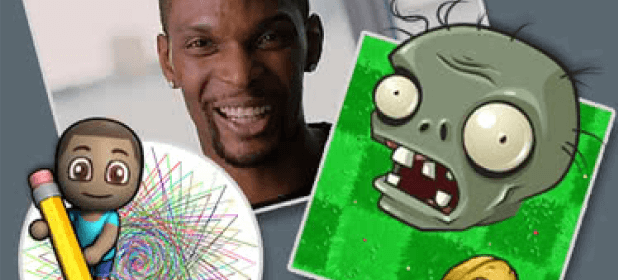
Learn to create computer programs, develop problem-solving skills, and work through fun challenges! Make games and creative projects to share with friends, family, and teachers.
No devices? We have you covered

Go ahead, cut the cord (for a while)!
CS education does not always need to be in front of a screen and device access shouldn't be a barrier to learning computer science concepts.
Resources that support you every step of the way
Sign up for a Code.org account to get access to materials that will help you teach computer science with confidence. Code.org has extensive resources designed to support educators, even those without prior CS teaching experience.
Lesson Plans
Get step-by-step guidance, learning objectives, and assessment strategies for effective teaching.
Helpful resources include slide decks, activity guides, rubrics, and more — all organized in one place. Each lesson plan is accompanied by tips for classroom implementation, differentiation ideas, and extension activities to cater to students of all abilities.
Instructional Videos
Watch easy-to-understand overviews of computer science and programming concepts.
Code.org video series are designed specifically to support your classroom and are engaging and fun to watch.
Slide Decks
We offer educators an organized, visually engaging, and pedagogically sound framework to deliver computer science lessons.
Code.org slide decks provide step-by-step instructions, examples, and interactive activities that align with curricular objectives.

Our curricula includes a comprehensive system of formative and summative assessment resources.
These include rubrics, checklists, mini-projects, end-of-chapter projects, student-facing rubrics, sample projects, and post-project tests — all designed to support teachers in measuring student growth, providing feedback, and evaluating student understanding.
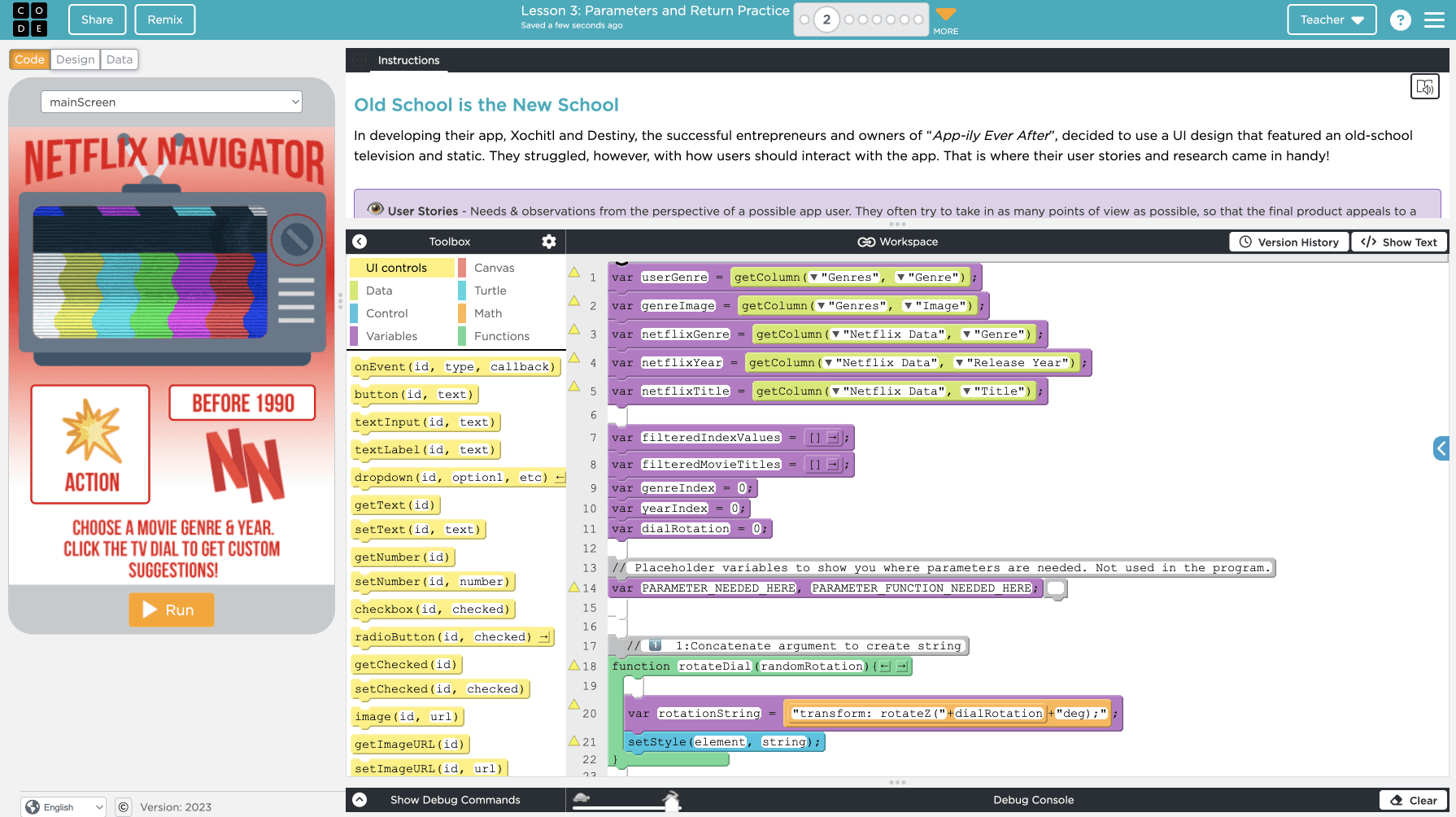
Programming Tools
Code.org's integrated development environments (IDEs) cater to students of all skill levels.
We offer a versatile and user-friendly platform that supports a variety of programming paradigms. This enables learners to seamlessly transition from block-based coding to text-based languages, and fosters creativity and innovation.
Professional learning that meets your needs
Get the support you need as you prepare to teach. Teachers love it, with over 90% ranking it the best professional development ever!
Facilitator-led Workshops
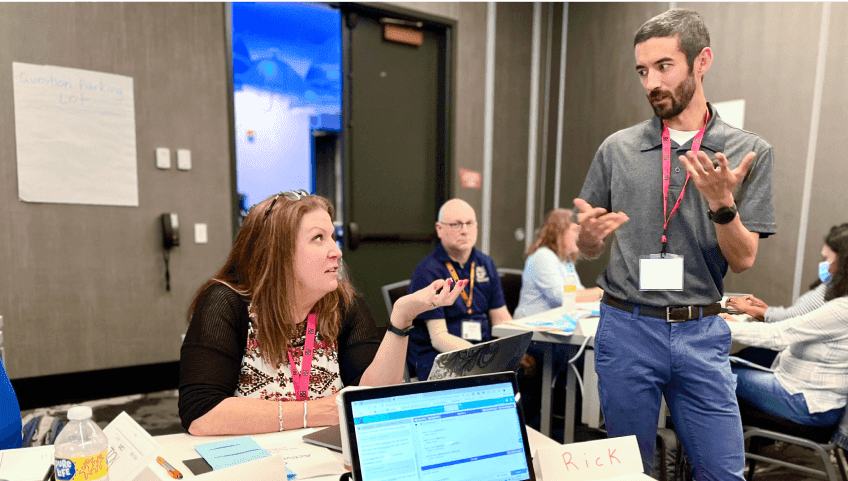
Join local teachers for inspiring and hands-on support to implement computer science in your classroom. Our Regional Partners offer high-quality, one-day Code.org workshops for individual teachers or for schoolwide PD. Sign up for a professional development workshop near you!
Self-Paced Online Modules

Through reading, viewing videos, completing interactive puzzles, and reflecting on your learning, you will develop your own understanding while preparing to teach computer science in your classroom.
Frequently asked questions
CS Fundamentals was written using both the K-12 Framework for Computer Science and the CSTA standards as guidance. Currently, every lesson in CS Fundamentals contains mappings to the relevant CSTA standards. The summary of all CSTA mappings for each course can be found at:
- Course A Standards
- Course B Standards
- Course C Standards
- Course D Standards
- Course E Standards
- Course F Standards
A Google Sheets version of the standards can be found at CSF Standards .
The leading K-12 CS curriculum in the United States, our elementary program has been proven effective in major urban school districts like Dallas, as well as small rural districts in Iowa. There is no need to hire specialists to teach CS. Our program is uniquely designed to support teachers new to CS while offering the flexibility to evolve lessons to fit student needs. Share this brochure with your school and district administrators, or suggest they take a look at our administrators page specially designed to answer administrators' most common questions.
Our curriculum and platform are available at no cost for anyone, anywhere, to teach!
New to teaching computer science? No worries! Most of our teachers have never taught computer science before. Join local teachers for inspiring and hands-on support to implement computer science in your classroom. Our Regional Partners offer high-quality, one-day Code.org workshops for individual teachers or for schoolwide PD. Sign up for a professional development workshop near you !
Join over 100,000 teachers who have participated in our workshops. The majority of our workshop attendees say, 'It's the best professional development I've ever attended.' In fact, 90% of attendees would recommend our program to other teachers !
Each CSF course includes 13-17 lessons designed for 45-minute periods. We recommend all students move from lesson to lesson at a pace set by the teacher. There are many teacher-led project levels designed to be experienced in unison while the skill-building lessons can be completed by students at their own pace.
Many lessons have handouts that guide students through activities. These resources can be printed or assigned digitally. Some lessons call for typical classroom supplies and manipulatives. Visit the CSF Syllabus to learn more .
Support and questions

Still have questions? Reach out to us! We are here to help.
Our support team is here to answer any questions you may have about starting teaching with Code.org. You can also ask other teachers about their experience on our teacher forums.
Subscribe for updates
Sign up to receive monthly emails about Code.org's Computer Science Fundamentals and get helpful reminders, tips, and updates sent right to your inbox.
You can unsubscribe at any time.
Please select your language

14 Best Team Building Problem Solving Group Activities For 2024
The best teams see solutions where others see problems. A great company culture is built around a collaborative spirit and the type of unity it takes to find answers to the big business questions.
So how can you get team members working together?
How can you develop a mentality that will help them overcome obstacles they have yet to encounter?
One of the best ways to improve your teams’ problem solving skills is through team building problem solving activities .
“86% of employees and executives cite lack of collaboration or ineffective communication for workplace failures.” — Bit.AI
These activities can simulate true-to-life scenarios they’ll find themselves in, or the scenarios can call on your employees or coworkers to dig deep and get creative in a more general sense.
The truth is, on a day-to-day basis, you have to prepare for the unexpected. It just happens that team building activities help with that, but are so fun that they don’t have to feel like work ( consider how you don’t even feel like you’re working out when you’re playing your favorite sport or doing an exercise you actually enjoy! )

What are the benefits of group problem-solving activities?
The benefits of group problem-solving activities for team building include:
- Better communication
- Improved collaboration and teamwork
- More flexible thinking
- Faster problem-solving
- Better proactivity and decision making
Without further ado, check out this list of the 14 best team-building problem-solving group activities for 2024!
Page Contents (Click To Jump)
Popular Problem Solving Activities
1. virtual team challenge.
Virtual Team Challenges are popular problem-solving activities that involve a group of people working together to solve an issue. The challenge generally involves members of the team brainstorming, discussing, and creating solutions for a given problem.
Participants work both individually and collaboratively to come up with ideas and strategies that will help them reach their goals.
Why this is a fun problem-solving activity: Participants can interact and communicate with each other in a virtual environment while simultaneously engaging with the problem-solving activities. This makes it an enjoyable experience that allows people to use their creative thinking skills, build team spirit, and gain valuable insights into the issue at hand.
Problem-solving activities such as Virtual Team Challenges offer a great way for teams to come together, collaborate, and develop creative solutions to complex problems.
2. Problem-Solving Templates
Problem-Solving Templates are popular problem-solving activities that involve a group of people working together to solve an issue. The challenge generally involves members of the team utilizing pre-made templates and creating solutions for a given problem with the help of visual aids.
This activity is great for teams that need assistance in getting started on their problem-solving journey.
Why this is a fun problem-solving activity: Problem-Solving Templates offer teams an easy and stress-free way to get the creative juices flowing. The visual aids that come with the templates help team members better understand the issue at hand and easily come up with solutions together.
This activity is great for teams that need assistance in getting started on their problem-solving journey, as it provides an easy and stress-free way to get the creative juices flowing.
Problem Solving Group Activities & Games For Team Building
3. coworker feud, “it’s all fun and games”.
Coworker Feud is a twist on the classic Family Feud game show! This multiple rapid round game keeps the action flowing and the questions going. You can choose from a variety of customizations, including picking the teams yourself, randomized teams, custom themes, and custom rounds.
Best for: Hybrid teams
Why this is an effective problem solving group activity: Coworker Feud comes with digital game materials, a digital buzzer, an expert host, and a zoom link to get the participants ready for action! Teams compete with each other to correctly answer the survey questions. At the end of the game, the team with the most competitive answers is declared the winner of the Feud.
How to get started:
- Sign up for Coworker Feud
- Break into teams of 4 to 10 people
- Get the competitive juices flowing and let the games begin!
Learn more here: Coworker Feud
4. Crack The Case
“who’s a bad mamma jamma”.
Crack The Case is a classic WhoDoneIt game that forces employees to depend on their collective wit to stop a deadly murderer dead in his tracks! Remote employees and office commuters can join forces to end this crime spree.
Best for: Remote teams
Why this is an effective problem solving group activity: The Virtual Clue Murder Mystery is an online problem solving activity that uses a proprietary videoconferencing platform to offer the chance for employees and coworkers to study case files, analyze clues, and race to find the motive, the method, and the individual behind the murder of Neil Davidson.
- Get a custom quote here
- Download the app
- Let the mystery-solving collaboration begin!
Learn more here: Crack The Case
5. Catch Meme If You Can
“can’t touch this”.
Purposefully created to enhance leadership skills and team bonding , Catch Meme If You Can is a hybrid between a scavenger hunt and an escape room . Teammates join together to search for clues, solve riddles, and get out — just in time!
Best for: Small teams
Why this is an effective problem solving group activity: Catch Meme If You Can is an adventure with a backstory. Each team has to submit their answer to the puzzle in order to continue to the next part of the sequence. May the best team escape!
- The teams will be given instructions and the full storyline
- Teams will be split into a handful of people each
- The moderator will kick off the action!
Learn more here: Catch Meme If You Can
6. Puzzle Games
“just something to puzzle over”.
Puzzle Games is the fresh trivia game to test your employees and blow their minds with puzzles, jokes , and fun facts!
Best for: In-person teams
Why this is an effective problem solving group activity: Eight mini brain teaser and trivia style games include word puzzles, name that nonsense, name that tune, and much more. Plus, the points each team earns will go towards planting trees in the precious ecosystems and forests of Uganda
- Get a free consultation for your team
- Get a custom designed invitation for your members
- Use the game link
- Dedicated support will help your team enjoy Puzzle Games to the fullest!
Learn more here: Puzzle Games
7. Virtual Code Break
“for virtual teams”.
Virtual Code Break is a virtual team building activity designed for remote participants around the globe. Using a smart video conferencing solution, virtual teams compete against each other to complete challenges, answer trivia questions, and solve brain-busters!
Why this is an effective problem solving group activity: Virtual Code Break can be played by groups as small as 4 people all the way up to more than 1,000 people at once. However, every team will improve their communication and problem-solving skills as they race against the clock and depend on each other’s strengths to win!
- Reach out for a free consultation to align the needs of your team
- An event facilitator will be assigned to handle all of the set-up and logistics
- They will also provide you with logins and a play-by-play of what to expect
- Sign into the Outback video conferencing platform and join your pre-assigned team
- Lastly, let the games begin!
Learn more here: Virtual Code Break
8. Stranded
“survivor: office edition”.
Stranded is the perfect scenario-based problem solving group activity. The doors of the office are locked and obviously your team can’t just knock them down or break the windows.
Why this is an effective problem solving group activity: Your team has less than half an hour to choose 10 items around the office that will help them survive. They then rank the items in order of importance. It’s a bit like the classic game of being lost at sea without a lifeboat.
- Get everyone together in the office
- Lock the doors
- Let them start working together to plan their survival
Learn more here: Stranded
9. Letting Go Game
“for conscious healing”.
The Letting Go Game is a game of meditation and mindfulness training for helping teammates thrive under pressure and reduce stress in the process. The tasks of the Letting Go Game boost resiliency, attentiveness, and collaboration.
Why this is an effective problem solving group activity: Expert-guided activities and awareness exercises encourage team members to think altruistically and demonstrate acts of kindness. Between yoga, face painting, and fun photography, your employees or coworkers will have more than enough to keep them laughing and growing together with this mindfulness activity!
- Reach out for a free consultation
- A guide will then help lead the exercises
- Let the funny videos, pictures, and playing begin!
Learn more here: Letting Go Game
10. Wild Goose Chase
“city time”.
Wild Goose Chase is the creative problem solving activity that will take teams all around your city and bring them together as a group! This scavenger hunt works for teams as small as 10 up to groups of over 5000 people.
Best for: Large teams
Why this is an effective group problem solving activity: As employees and group members are coming back to the office, there are going to be times that they’re itching to get outside. Wild Goose Chase is the perfect excuse to satisfy the desire to go out-of-office every now and then. Plus, having things to look at and see around the city will get employees talking in ways they never have before.
- Download the Outback app to access the Wild Goose Chase
- Take photos and videos from around the city
- The most successful team at completing challenges on time is the champ!
Learn more here: Wild Goose Chase
11. Human Knot
“for a knotty good time”.

The Human Knot is one of the best icebreaker team building activities! In fact, there’s a decent chance you played it in grade school. It’s fun, silly, and best of all — free!
Why this is an effective group problem solving activity: Participants start in a circle and connect hands with two other people in the group to form a human knot. The team then has to work together and focus on clear communication to unravel the human knot by maneuvering their way out of this hands-on conundrum. But there’s a catch — they can’t let go of each other’s hands in this team building exercise.
- Form a circle
- Tell each person to grab a random hand until all hands are holding another
- They can’t hold anyone’s hand who is directly next to them
- Now they have to get to untangling
- If the chain breaks before everyone is untangled, they have to start over again
Learn more here: Human Knot
12. What Would You Do?
“because it’s fun to imagine”.

What Would You Do? Is the hypothetical question game that gets your team talking and brainstorming about what they’d do in a variety of fun, intriguing, and sometimes, whacky scenarios.
Best for: Distributed teams
Why this is an effective group problem solving activity: After employees or coworkers start talking about their What Would You Do? responses, they won’t be able to stop. That’s what makes this such an incredible team building activity . For example, you could ask questions like “If you could live forever, what would you do with your time?” or “If you never had to sleep, what would you do?”
- In addition to hypothetical questions, you could also give teammates some optional answers to get them started
- After that, let them do the talking — then they’ll be laughing and thinking and dreaming, too!
13. Crossing The River
“quite the conundrum”.

Crossing The River is a river-crossing challenge with one correct answer. Your team gets five essential elements — a chicken, a fox, a rowboat, a woman, and a bag of corn. You see, the woman has a bit of a problem, you tell them. She has to get the fox, the bag of corn, and the chicken to the other side of the river as efficiently as possible.
Why this is an effective group problem solving activity: She has a rowboat, but it can only carry her and one other item at a time. She cannot leave the chicken and the fox alone — for obvious reasons. And she can’t leave the chicken with the corn because it will gobble it right up. So the question for your team is how does the woman get all five elements to the other side of the river safely in this fun activity?
- Form teams of 2 to 5 people
- Each team has to solve the imaginary riddle
- Just make sure that each group understands that the rowboat can only carry one animal and one item at a time; the fox and chicken can’t be alone; and the bag of corn and the chicken cannot be left alone
- Give the verbal instructions for getting everything over to the other side
14. End-Hunger Games
“philanthropic fun”.
Does anything bond people quite like acts of kindness and compassion? The End-Hunger Games will get your team to rally around solving the serious problem of hunger.
Best for: Medium-sized teams
Why this is an effective problem solving group activity: Teams join forces to complete challenges based around non-perishable food items in the End-Hunger Games. Groups can range in size from 25 to more than 2000 people, who will all work together to collect food for the local food bank.
- Split into teams and compete to earn boxes and cans of non-perishable food
- Each team attempts to build the most impressive food item construction
- Donate all of the non-perishable foods to a local food bank
Learn more here: End-Hunger Games
People Also Ask These Questions About Team Building Problem Solving Group Activities
Q: what are some problem solving group activities.
- A: Some problem solving group activities can include riddles, egg drop, reverse pyramid, tallest tower, trivia, and other moderator-led activities.
Q: What kind of skills do group problem solving activities & games improve?
- A: Group problem solving activities and games improve collaboration, leadership, and communication skills.
Q: What are problem solving based team building activities & games?
- A: Problem solving based team building activities and games are activities that challenge teams to work together in order to complete them.
Q: What are some fun free problem solving games for groups?
- A: Some fun free problem solving games for groups are kinesthetic puzzles like the human knot game, which you can read more about in this article. You can also use all sorts of random items like whiteboards, straws, building blocks, sticky notes, blindfolds, rubber bands, and legos to invent a game that will get the whole team involved.
Q: How do I choose the most effective problem solving exercise for my team?
- A: The most effective problem solving exercise for your team is one that will challenge them to be their best selves and expand their creative thinking.
Q: How do I know if my group problem solving activity was successful?
- A: In the short-term, you’ll know if your group problem solving activity was successful because your team will bond over it; however, that should also translate to more productivity in the mid to long-term.
Interested in a content partnership? Let’s chat!
Get Started

About SnackNation

SnackNation is a healthy office snack delivery service that makes healthy snacking fun, life more productive, and workplaces awesome. We provide a monthly, curated selection of healthy snacks from the hottest, most innovative natural food brands in the industry, giving our members a hassle-free experience and delivering joy to their offices.

Popular Posts
Want to become a better professional in just 5 minutes?
You May Also Like

❤️ Revolutionizing Women’s Well-Being: 16 Women’s Health and Wellness Companies
76 Creative & Thoughtful Gifts For Managers In 2024
Asian American and Pacific Islander Heritage Month Ideas & AAPI Activities For Work [May 2024]
Leave a Reply Cancel Reply
Save my name, email, and website in this browser for the next time I comment.
SnackNation About Careers Blog Tech Blog Contact Us Privacy Policy Online Accessibility Statement
Pricing How It Works Member Reviews Take the Quiz Guides and Resources FAQ Terms and Conditions Website Accessibility Policy
Exciting Employee Engagement Ideas Employee Wellness Program Ideas Thoughtful Employee Appreciation Ideas Best ATS Software Fun Office Games & Activities for Employees Best Employee Engagement Software Platforms For High Performing Teams [HR Approved] Insanely Fun Team Building Activities for Work
Fun Virtual Team Building Activities The Best Employee Recognition Software Platforms Seriously Awesome Gifts For Coworkers Company Swag Ideas Employees Really Want Unique Gifts For Employees Corporate Gift Ideas Your Clients and Customers Will Love
© 2024 SnackNation. Handcrafted in Los Angeles
- Recipient Choice Gifts
- Free Work Personality Assessment
- Happy Hour & Lunches
- Group eCards
- Office Snacks
- Employee Recognition Software
- Join Our Newsletter
- Partner With Us
- SnackNation Blog
- Employee Template Directory
- Gifts For Remote Employees
- ATS Software Guide
- Best Swag Vendors
- Top HR Tools
- Ways To Reward Employees
- Employee Appreciation Gift Guide
- More Networks
- Privacy Overview
- Strictly Necessary Cookies
- 3rd Party Cookies
This website uses cookies so that we can provide you with the best user experience possible. Cookie information is stored in your browser and performs functions such as recognising you when you return to our website and helping our team to understand which sections of the website you find most interesting and useful.
Strictly Necessary Cookie should be enabled at all times so that we can save your preferences for cookie settings.
If you disable this cookie, we will not be able to save your preferences. This means that every time you visit this website you will need to enable or disable cookies again.
This website uses Google Analytics to collect anonymous information such as the number of visitors to the site, and the most popular pages.
Keeping this cookie enabled helps us to improve our website.
Please enable Strictly Necessary Cookies first so that we can save your preferences!

We've got more than 25,000 unique puzzles available for play, both online and the old fashioned way - with pencil and paper. Feel free to solve online just for fun, or, for an added challenge, register a free account and compete against thousands of other solvers to make it into our Logic Puzzle Hall of Fame! Start a New Puzzle »
Brain games feature problem-solving puzzles that may help improve one or more aspects of your cognition. They can feature abstract logic, math, memory recall, and sometimes questions similar to those you may find on an IQ test. Play the Best Online Brain Games for Free on CrazyGames, No Download or Installation Required. 🎮 Play Words of ...
Play our range of fun online brain games and improve your strategic thinking, quantitative skills and vocabulary. Instantly play online for free. ... Brain games are often used in early education to help children develop problem-solving, logical skills. Certain types of casual games, like brain games, were proven in a study to be just as ...
Braingle is a place to solve puzzles, brush up on your trivia, play games and give your brain a workout. Get ready to have your brain tangled! With over 15,000 brain teasers, riddles, logic problems and mind puzzles submitted and ranked by users like you, Braingle has the largest collection anywhere on the internet! Try a Brain Teaser!
After 10 weeks, Lumosity users improved more than the control group on our assessments of working memory, short term memory, processing speed, problem solving, fluid reasoning, and overall cognitive function. These results are promising, but more research is needed to determine the connection between improved assessment scores and everyday ...
Hundreds of free, online math games that teach multiplication, fractions, addition, problem solving and more. Teacher created and classroom approved. Give your brain a workout!
Algebra has a reputation for being difficult, but Math Games makes struggling with it a thing of the past. Kids can use our free, exciting games to play and compete with their friends as they progress in this subject! Solving and writing variable equations to find answers to real-world problems. Writing, simplifying and evaluating variable ...
Guided interactive problem solving that's effective and fun. Master concepts in 15 minutes a day. Get started Math Data Analysis Computer Science Programming & AI ... game-like progress tracking, and friendly reminders. Guided courses for every journey. All of our courses are crafted by award-winning teachers, researchers, and professionals ...
This free online matching game has endless surprises and challenges to entertain you for hours. Whether you're looking to strengthen your problem solving skills or unwind and enjoy the satisfaction found in this organizing game of sorting and matching various amusing objects, Journey Match 3D is the game for you.
Art of Problem Solving's Premier Game. FTW has it all: an unparalleled array of MATHCOUNTS-style problems, elite competition, customizable games, and player rankings. If you're looking to sharpen your competition skills, or just want to engage in good old-fashioned mathematical battle with friends or strangers, then this is the arena for you.
These games aren't all fancy graphics and silliness; the focus is on the educational value for students, so those who play our games will get the most puzzling, problem solving, and learning, in a compact time frame. Our games include word games, math games, strategy games, and even a handful of games specifically designed for young children.
Problem 6. Math Playground has hundreds of interactive math word problems for kids in grades 1-6. Solve problems with Thinking Blocks, Jake and Astro, IQ and more. Model your word problems, draw a picture, and organize information!
19. Proverbs to exercise your memory and reasoning. 20. Find the missing number in The Empty Triangle. 21. Good puzzle for the whole brain: The Blind Beggar. 22. Find the the Really, Really, Really Big Number.
Give your brain a workout with these kids problem solving games and interactive activities. Find cool number problems and exercises as well as challenges that will test your logical thinking and reasoning abilities. Help a frog jump stones, measure water with limited resources, get people safely across a bridge and more.
Art of Problem Solving offers two other multifaceted programs. Beast Academy is our comic-based online math curriculum for students ages 6-13. And AoPS Academy brings our methodology to students grades 2-12 through small, in-person classes at local campuses. Through our three programs, AoPS offers the most comprehensive honors math pathway ...
Kids design pools with specific areas and use multiple problem-solving strategies in this game. 4th grade. Math. Game. Add Up the Fantasy Coins. Game. Add Up the Fantasy Coins. Kids solve a multi-step word problem by counting out the right number of coins. 1st grade. Math. Game. Zap and Kreb: Graphing Word Problems.
Through Math Game Time's free problem solving videos, children learn how to solve word problems and apply their math skills to other scenarios. The free worksheets complement these videos nicely by having children test their problem-solving skills on their own. From there, children can move to solving problems at they play our free problem ...
PLAY NOW. MentalUP Brain Stimulators Games for Kids help kids improve their skills including visual attention, divided attention, selective attention, focusing, problem-solving, and imagination. Improve your child's cognitive skills with online mind games, have fun, and learn at the same time! PLAY FOR FREE.
Problem Solving Games for Students. Problem-solving is an important skill to learn and work at. Every problem has a solution and there are skills you can practice in order to come to those solutions easily and quickly. Through critical thinking, logic, and consideration, you'll be able to solve many problems every day.
Learn how to improve your problem solving skills with 50 fun and creative activities, games and puzzles for remote teams. From decision making to team building, from creative to analytical, from easy to challenging, find the best activity for your team and situation.
22. Ultimate Game Show. If you're looking for high-energy virtual problem-solving activities for competitive teams, then the Ultimate Game Show is the perfect fit. In this 90-minute virtual event, players bond together as a team while playing different quizzes to win the final prize.
For this problem solving activity for older kids or teens, you will need four 2×6 boards. Divide your group into two teams with an equal number of children on each team. Place two of the four boards end to end on the ground or floor. Set the other two parallel to the first two about two or three feet apart.
With its sleek design and intuitive interface, Code Breaker Deluxe is the perfect choice for gamers of all levels. Whether you're a seasoned master in mind enthusiast or a newcomer to the genre, our game is sure to provide hours of entertainment and endless fun. Enjoy playing this game here at Y8.com! Category: Arcade and Classic Games.
Topics: Programming, Internet, Games and Animation, Art and Design, App Design Programming Tools: Sprite Lab, Play Lab ... Create programs with sequencing, loops, and events. Investigate problem-solving techniques and develop strategies for building positive communities both online and offline. Create interactive games that students can share.
Jeopardy. Problem-solving activities such as Virtual Team Challenges offer a great way for teams to come together, collaborate, and develop creative solutions to complex problems. 2. Problem-Solving Templates. Problem-Solving Templates are popular problem-solving activities that involve a group of people working together to solve an issue.
La Classe du Littéraire
Explications de textes, biographies d'auteurs, méthodologie, grammaire … Tout pour le Bac de Français et les études littéraires.
Gargantua Chapitre 23, L’éducation de Gargantua : Analyse Linéaire (Bac 2024)
Vous préparez l’oral du bac de français ? Vous avez travaillé sur Gargantua de François Rabelais et vous voulez compléter vos cours ? Alors cette analyse linéaire du chapitre 23 sur “L’éducation de Gargantua” est pour vous !
C’est un passage très célèbre qui fait l’éloge d’un modèle d’éducation humaniste.
L’analyse présentée ici propose un cadre que vous pouvez suivre et reproduire lors de l’épreuve anticipée de français. Vous pouvez bien entendu modifier la problématique, ou certaines analyses à votre convenance.
Avant de commencer à lire cette analyse, n’hésitez pas à vous reporter à mon article “ comment analyser un texte en français ”, à ma “ méthode de l’explication linéaire ” ainsi qu’à mon article sur le vocabulaire de la poésie pour mieux comprendre ma démarche.
Introduction de l’analyse linéaire du chapitre 23 sur “L’éducation de Gargantua”
Présentation de l’auteur.

Ce que l’on sait de François Rabelais est assez imprécis. Il est vers 1483 et mort en 1553. Entre temps, il sera devenu l’un des plus grands écrivains du mouvement Humaniste du début du XVIe.
Assoiffé de connaissance, il exercera tour à tour les professions de prêtre, médecin, et bien sûr, savant et écrivain. C’est l’humaniste par excellence : il questionne, traduit, cherche à revenir aux textes antiques, et se passionne des questions d’éducation et de religion.
Présentation de l’oeuvre
Son oeuvre la plus connue, c’est indéniablement le roman Gargantua , publié en 1534 : ouvrage pédagogique et critique rédigé sous la forme d’une geste farcesque.
Ce roman synthétise toute la pensée humaniste de François Rabelais, et notamment un modèle éducatif qui diffère de la scolastique Moyenâgeuse de La Sorbonne, et des enseignement religieux de l’église catholique.
Pour éviter la censure, Rabelais le publie sous le pseudonyme d’Alcofribas Nasier, anagramme de son véritable nom.
Présentation du passage
Gargantua est encore jeune, et face à l’échec de son éducation, son père, Grandgousier décide de l’envoyer à Paris pour être pris en charge par un nouveau précepteur : Ponocrates. Ce dernier lui inculquera une éducation très différente, basée sur le modèle humaniste.
Problématique
Ainsi, nous pourrons nous demander comment le récit d’une matinée de Gargantua met en valeur un modèle éducatif humaniste ?
Pour mener cette analyse linéaire du chapitre 23 sur “L’éducation de Gargantua” , nous suivrons les mouvements du texte. D’abord le réveil de Gargantua de “Gargantua” à “difficiles”, ensuite la préparation de Gargantua de “en revenant” à “habillé”, puis la pratique du sport de “Ensuite” à “leçon”, enfin, l’heure du repas de “Cependant” à la fin du passage.
Texte du chapitre 23 sur “L’éducation de Gargantua” pour l’analyse linéaire
Ensuite, il le soumit à un rythme de travail tel qu’il ne perdait pas une heure de la journée mais consacrait au contraire tout son temps aux lettres et aux études libérales. Gargantua s’éveillait donc vers quatre heures du matin. Pendant qu’on le frictionnait, on lui lisait quelque page des Saintes Écritures, à voix haute et claire, avec la prononciation requise. Cet office était dévolu à un jeune page natif de Basché, nommé Anagnostes [1] . Suivant le thème et le sujet du passage, bien souvent il s’appliquait à révérer, adorer, prier, et supplier le bon Dieu dont la majesté et les merveilleux jugements apparaissaient à la lecture.
Puis il allait aux lieux secrets excréter le produit des digestions naturelles. Là, son précepteur répétait ce qu’on avait lu et lui expliquait les passages les plus obscurs et les plus difficiles. En revenant, ils considéraient l’état du ciel, regardant s’il était comme ils l’avaient remarqué la veille au soir et en quels signes entrait le soleil, et aussi la lune, ce jour-là. Cela fait, il était habillé, peigné, coiffé, apprêté et parfumé et, pendant ce temps, on lui répétait les leçons de la veille. Lui- même les récitait par cœur et expliquait des exemples pratiques concernant la condition humaine ; ils poursuivaient quelquefois ce propos pendant deux ou trois heures, mais d’habitude ils s’arrêtaient quand il était complètement habillé.
Ensuite, pendant trois bonnes heures, on lui faisait la lecture. Cela fait, ils sortaient, toujours en discutant du sujet de la lecture, et allaient faire du sport au Grand Braque [2] ou dans les prés ; ils jouaient à la balle, à la paume, au ballon à trois, s’exerçant élégamment les corps, comme ils s’étaient auparavant exercé les âmes.
Tous leurs jeux n’étaient que liberté, car ils abandonnaient la partie quand il leur plaisait et ils s’arrêtaient en général quand la sueur leur coulait par le corps ou qu’ils ressentaient autrement la fatigue. Ils étaient alors très bien essuyés et frottés, ils changeaient de chemise et allaient voir si le repas était prêt, en ce promenant doucement. Là, en attendant, ils récitaient à voix claire et en belle élocution quelques formules retenues de la leçon.
Cependant, Monsieur l’Appétit venait et c’était juste au bon moment qu’ils s’asseyaient à table.
[1] mot grec signifiant lecteur
[2] célèbre jeu de Paume parisien
Chapitre 23 sur “L’éducation de Gargantua” : Analyse linéaire
I. le réveil de gargantua.
Dès le début de l’extrait, le narrateur insiste sur l’intensité de l’éducation humaniste. Gargantua doit se lever « vers quatre heures du matin », ce qui est très tôt, afin d’occuper chaque heure de la journée par le travail, l’exercice physique, ou le jeu.
Dès le réveil de son esprit, son corps doit suivre puisqu’il est « frictionn(é) ». Cela témoigne de l’importance du corps dans l’éducation humaniste.
On note également l’utilisation de l’imparfait à valeur itérative qui souligne l’importance de la régularité et de l’habitude dans ce modèle éducatif : « s’éveillait » ; « frictionnait » ; « lisait ».
Ensuite, la première chose qu’entend Gargantua est une lecture des « saintes Écritures ». Cette primauté de la religion est héritée du Moyen Âge, mais il faut remarquer une différence notable : la lecture est faite à « voix haute et claire, avec la prononciation requise ».
Les adjectifs « haute et claire » suggèrent la clarté et la compréhension : pas question donc de marmonner d’immenses passages de la bible comme c’est le cas dans les abbayes. Au contraire, la lecture doit permettre une totale compréhension du contenu.
On voit ici la volonté humaniste de revenir au sens original des textes sacrés, notamment en révisant les traductions afin de les rendre intelligibles à tous.
Anagnotes qui lui fait la lecture (et dont le nom Grec signifie justement lecteur) cherche à faire apparaître la « majesté » du « bon Dieu » et ses « merveilleux jugements ». Ce lexique mélioratif composé d’adjectifs et de noms positifs rappelle au lecteur l’importance de Dieu pour les humanistes.
Enfin, on remarquer l’énumération de verbes à l’infinitif : « révérer, adorer, prier et supplier le bon Dieu » qui placent l’homme dans un état d’adoration face à Dieu. C’est un pilier de l’éducation humaniste : l’homme est au centre et cherche à s’améliorer, mais ne renie pas Dieu son créateur.
Le lecteur peut être surpris par l’arrivée soudaine d’un passage presque burlesque au comique à la limite du scatologique.
Gargantua se rend « aux lieux secrets » pour « excréter le produit des digestions naturelles. » Le verbe « excréter » semble très direct et cru à côté de la périphrase « le produit des digestions naturelles ».
L’adverbe complément circonstanciel de lieu « Là » indique pudiquement, mais avec un certain humour, que le précepteur suit son élève aux toilettes pour ne pas perdre un instant du temps dédié à l’éducation de Gargantua.
Cependant, on remarque qu’ici, les choses naturelles du corps sont acceptées et absolument pas moquées (utilisation de l’adjectif « naturelles » dans la périphrase).
D’ailleurs, elles n’interrompent même pas la leçon qui se poursuit (« son précepteur répétait ») et même s’intensifie (« lui expliquait les passages les plus obscurs et les plus difficiles.)
Le parallélisme de construction insiste ici, sur le ton de l’humour, sur le fait que le précepteur profite de la concentration de son élève en train de soulager ses besoins naturels pour revenir sur les aspects les plus complexes de la Bible.
II. La préparation de Gargantua
Alors qu’il revient des toilettes, toujours pas habillé, Gargantua observe « l’état du ciel » avec son précepteur.
La comparaison avec « la veille » montre que c’est une pratique régulière à laquelle ils s’adonnent au moins matin et soir. Cela fait référence aux récentes découvertes humanistes concernant l’astronomie, notamment par Galilée.
La phrase suivante est une phrase passive constituée d’une énumération de participes passés : « il était habillé, peigné, coiffé, apprêté et parfumé ».
Elle montre d’une part l’attention qui est portée au soin du corps et à l’apparence (la cour de François Ier est une cour où l’on fait attention à l’apparence et l’hygiène).
D’autre part, on remarque que la phrase passive est construite sans complément d’agent. Aussi, On peut affirmer que Gargantua est au centre de la démarche et que ceux qui s’occupent de lui comptent peu ; ils sont d’ailleurs désignés par le pronom impersonnel « on ».
L’écoute et le par cœur ont une grande importance dans l’éducation humaniste, en témoigne l’imparfait à valeur itérative « répétait » qui confirme que les leçons sont ancrées par la répétition.
Toutefois, l’éducation humaniste n’est pas uniquement un modèle vertical où le savoir descend du maître vers l’élève. On voit bien que Gargantua est actif (« lui-même les récitait par cœur » et qu’il doit mettre en pratique ce qu’il apprend (« y appliquait des exemples pratiques »).
La réflexion sur l’homme et « la condition humaine » (qui donne d’ailleurs son nom aux humanistes) est au centre de la démarche éducative, et n’est pas vraiment bornée dans le temps ; elle peut atteindre plusieurs heures : « ils poursuivaient quelquefois ce propos pendant deux ou trois heures. »
On constate ici que l’élève semble intéressé par l’apprentissage humaniste et souhaite donc poursuivre les discussions avec son précepteur. Cela souligne le fait que l’apprentissage est plus efficace sous forme dialoguée que verticale.
Enfin, le complément circonstanciel de fréquence « d’habitude » à la fin de la phrase montre l’importance d’un enseignement cyclique où le professeur et l’élève développent des rituels d’apprentissage.
III. L’activité physique de Gargantua
L’activité suivante est introduite par l’adverbe de temps « ensuite », ce qui donne l’impression d’un enchaînement ininterrompu d’apprentissages, et donc d’un emploi du temps bien rempli.
Il s’agira donc de la lecture, qui prendra « trois bonnes heures ». Ici l’adjectif « bonnes » ajoute à la longueur du temps imparti à la lecture, l’idée qu’il est bien dépensé, de manière agréable.
L’importance de l’écrit pour les humanistes est à souligner. De nombreux textes sont traduits, analysés, ou écrits à cette époque.
La suite du programme est dédiée au sport en extérieur : « ils sortaient (…) et allaient faire du sport ». Les sports pratiqués sont populaires et à la mode.
Le Grand Braque est un lieu célèbre pour le jeu de paume à l’époque, et les activités pratiquées font le bonheur des cours les plus distinguées : « la balle » ; le « ballon à trois ».
On notera donc que les sports sont des jeux à plusieurs, ce qui accentue l’importance du caractère social. L’homme humaniste est un être de société et non un savant isolé. C’est cela qui doit donc être transmis dans ce modèle éducatif.
De plus, on peut remarquer la référence à Juvénal (un esprit sain dans un corps sain) qui est mise en valeur par le polyptote et le parallélisme : « s’exerçant élégamment les corps, comme ils s’étaient auparavant exercé les âmes.
Le narrateur revient ensuite sur la caractérisation du sport pratiqué avec la négation restrictive « tous leurs jeux n’étaient que liberté ». On constate que le bien-être de l’élève est au centre de ce modèle éducatif car « ils abandonnaient la partie quand il leur plaisait ».
Ainsi le but de la pratique sportive est de distraire et elle n’a aucun caractère contraignant : Gargantua s’y livre avec plaisir.
D’ailleurs, ce n’est pas parce qu’il peut choisir d’arrêter quand il veut qu’il ne se livre pas à l’exercice de manière intensive : « ils s’arrêtaient en général quand la sueur leur coulait par le corps », cela montre bien qu’il pratique un exercice difficile.
La fin de la séance de jeux est consacrée à l’hygiène, très importante pour les humanistes (dans l’idée de prendre soin du corps). Aussi Gargantua et son précepteur sont-ils « essuyés et frottés », de plus ils « chang(ent) de chemise ».
L’adverbe « doucement » qui précise l’action de la promenade donne une image apaisée de la fin du sport. On voit que l’éducation de Ponocrates porte ses fruits et que Gargantua n’est plus agité comme il a pu l’être avec d’autres précepteurs. L’éducation humaniste est donc un modèle de réussite.
C’est ainsi dans cet état apaisé, propice à l’apprentissage que Gargantua et son maître consolident les apprentissages du jour : « ils récitaient à voix claire et en belle élocution quelques formules retenues de la leçon. » Cela montre bien l’importance de prendre soin de son corps pour que l’esprit soit plus performant.
IV. L’arrivée de l’appétit
La matinée se clôt sur une touche d’humour avec l’arrivée de l’appétit personnifié : « Monsieur l’Appétit venait ». On peut affirmer que même lors des repas, le comportement de Gargantua reste distingué grâce à l’éducation de Ponocrates.
En effet, le titre de « Monsieur » qui précède l’appétit donne l’impression d’une sensation distinguée plutôt que d’un impérieux besoin.
Par ailleurs, le programme de Ponocrates est si bien pensé que la faim arrive « juste au bon moment ». La matinée a donc permis à Gargantua d’apprendre de nombreuses choses, de travailler la bible, d’observer le ciel, de jouer et de faire du sport, tout en s’installant à table à l’exacte heure du repas.
Conclusion de l’analyse linéaire du chapitre 23 sur “L’éducation de Gargantua”
Rappel du développement.
Nous avons pu voir qu’en insistant sur la différence entre le comportement de Gargantua face à ses anciens précepteur et face à Ponocrates, Rabelais montre la réussite d’un modèle d’éducation humaniste.
D’abord, il présente une journée bien remplie ou chaque minute est l’occasion d’un apprentissage, puis il montre un intérêt tout particulier pour le soin du corps dans la suite de Juvenal : un esprit sain dans un corps sain .
Réponse à la problématique
En décrivant d’un ton plaisant le programme imposé au géant Gargantua, François Rabelais dessine les contours d’un modèle éducatif plus performant que celui pratiqué dans les universités au Moyen Âge qui favorise trop le par coeur sur la réflexion : une éducation humaniste.
On y remarque notamment l’intérêt pour l’élève qui doit à la fois apprendre et pratiquer, prendre autant soin de son corps que son esprit, et enfin l’importance d’une lecture claire et compréhensible des textes religieux, ce qui s’oppose aux pratiques de l’époque par l’église catholique.
L’Humanisme n’est pas un mouvement qui se réduit à Rabelais, ni à la France. Il s’agit d’une mouvance intellectuelle qui transcende les frontières européennes.
Cependant les idées et principes sont communs aux penseurs de différents pays et décennies.
À ce titre, il est très intéressant d’approfondir les principes de la pédagogie humaniste, que l’on trouve développés et élargis à la société dans les chapitre 52 à 58 du roman , au sein de l’abbaye de Thélème : utopie humaniste imaginée par Rabelais dans le cadre d’une abbaye d’un genre nouveau.
Prolongements sur l’analyse linéaire du chapitre 23 sur “L’éducation de Gargantua”
Vous trouverez ici une liste des 25 figures de style à connaître pour le Bac . Pour ficher efficacement votre explication : https://la-classe-du-litteraire.com/comment-ficher-une-explication-lineaire/ et enfin, les erreurs à éviter à l’oral du Bac : https://la-classe-du-litteraire.com/bien-reussir-son-explication-lineaire/
Besoin d’une aide personnalisée ?
Je propose également des cours particuliers pour tous niveaux :
- Préparation d’examens
- Stages méthodologiques
- Révisions culture littéraire
- Grammaire et orthographe
- Et bien d’autres possibilités
Le tout en 100% distanciel (par WebCam) à partir de 50 euros / heure .
N’hésitez pas à me contacter ( [email protected] ) pour davantage de renseignements, et pour réserver votre premier cours !
Recommended Articles

Tous Des Oiseaux – Scène 19 – Analyse

On ne badine pas avec l’amour, Acte III scène 3 : Analyse Linéaire

À La Musique d’Arthur Rimbaud : Analyse Linéaire (Bac 2024)
Leave a comment cancel reply.
Your email address will not be published. Required fields are marked *
Save my name, email, and website in this browser for the next time I comment.
College of Natural Sciences and Mathematics
News & events, more than 700 nsm degree candidates honored at uh commencement.
May 10, 2024
Commencement Celebrates Spring Graduates, Including Five Summa Cum Laude 4.0 Grads
Bachelor’s, master’s and doctoral degree candidates were celebrated during the University of Houston Commencement for the College of Natural Sciences and Mathematics (NSM) on May 10. The ceremony was held at UH’s Fertitta Center.

More than 700 NSM students completed degree requirements for spring 2024. NSM’s 56 doctoral candidates earned degrees in biochemistry, biology, chemistry, computer science, geology, geophysics, mathematics, and physics. There were 91 master’s degree candidates and 609 candidates for bachelor’s degrees.
Sixty-three students graduated summa cum laude, the highest academic honor for bachelor’s degree recipients. An additional 198 students graduated either cum laude or magna cum laude.
Nineteen students graduated through the teach HOUSTON program, a collaboration between NSM and the College of Education. They have committed to teach high school math or science.
The ceremony also included remarks from Julian Chenin, board member of the NSM Alumni Association.
Dan E. Wells Outstanding Dissertation Award – Xin Shi
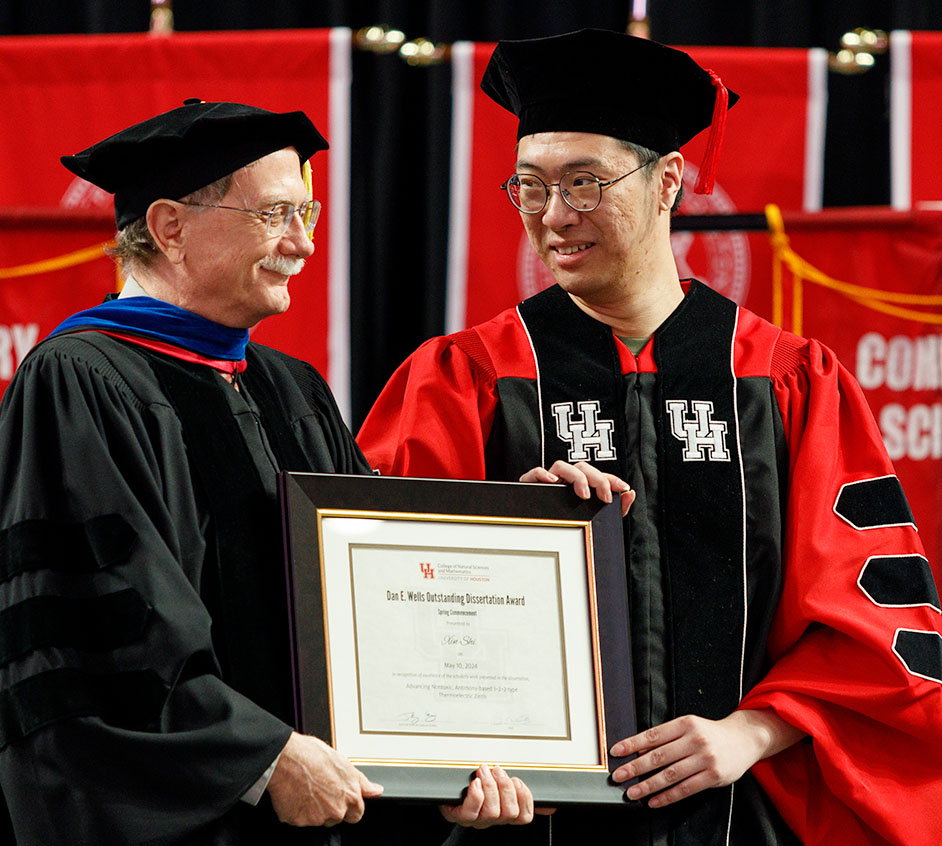
Each semester, the Dan E. Wells Outstanding Dissertation Award is presented to a doctoral student who has performed outstanding research and submitted the best dissertation to the College. The Spring 2024 recipient was Xin Shi, a physics Ph.D. graduate. He received a certificate and an award of $1,000.
Shi’s dissertation is titled “Advancing Nontoxic, Antimony-based 1–2–2-type Thermoelectric Zintls.” His research, conducted under the supervision of Professor Zhifeng Ren, focuses on the direct conversion of thermal energy, which is abundant in our environment, to electrical energy, which powers our society.
Current thermoelectric materials that can help accomplish this conversion have been laborious to design, and they often contain toxic or rare elements. Shi has researched fundamental properties of promising thermoelectric materials, and he has developed a new strategy to design and pre-evaluate nontoxic, highly performing thermoelectric compounds. These advances will have an ongoing positive impact in future environmentally friendly energy sources.
He will next pursue postdoctoral research with a goal of becoming a research-active faculty member.
Commencement Student Speaker – Chris Andrade

Commencement student speaker Chris Andrade is a first-generation college student graduating with a bachelor’s degree in mathematics. Andrade was selected as speaker through a competition that is open to all NSM summa cum laude graduates.
During his speech, Andrade reminded graduates that they are an inspiration to individuals across the world, showing that it is possible to make your dreams come true. He also encouraged graduates as they continue their journeys to “remember to be that ray of light in someone’s darkness and to help those who need it when you can.”
While at UH, he received numerous scholarships, including support from the UH and NSM Alumni Associations and the British American Foundation of Texas’ STEM scholarship program. Andrade was active in the University bands – the “Spirit of Houston” and “Cougar Brass.” He served in Kappa Kappa Psi, a Moores School of Music service organization, participating in volunteer activities for the school and other local organizations.
Andrade will enter the UH Department of Mathematics master’s program in statistics and data science in the fall. He plans to enter a Ph.D. program in data science after completing his master’s degree.
NSM’s 4.0 Summa Cum Laude Graduates

During the ceremony, NSM recognized five exceptional students who completed their college career with a perfect 4.0 grade point average.
- Chris Andrade, Mathematics
- Armando Espinoza, Computer Science
- Woosung Nam, Computer Science
- Tran Nguyen, Biology
- Melika Salehi, Biology
Commencement Banner Bearers – NSM Outstanding Students

The Commencement processional included outstanding students from NSM’s six departments carrying the college and departmental banners.
- College Banner: Melika Salehi
- Department of Biology and Biochemistry: Tran Nguyen
- Department of Chemistry: Preston Edwards
- Department of Computer Science: Woosung Nam
- Department of Earth and Atmospheric Sciences: Tyler Mai
- Department of Mathematics: Chris Andrade
- Department of Physics: Mazen Malak
- Kathy Major, College of Natural Sciences and Mathematics
Consulter le journal
« 32 h ! La semaine de quatre jours, c’est possible » : un plaidoyer pour une nouvelle réduction du temps de travail
Dans son dernier essai, le député européen Pierre Larrouturou explique pourquoi le passage aux 32 heures de travail hebdomadaires réparties sur quatre jours permettrait, selon lui, de concilier efficacité économique et bien-être social.
Par François Desnoyers
Temps de Lecture 2 min.
- Ajouter à vos sélections Ajouter à vos sélections
- Partager sur Twitter
- Partager sur Messenger
- Partager sur Facebook
- Envoyer par e-mail
- Partager sur Linkedin
- Copier le lien
Article réservé aux abonnés
Les planètes seraient-elles en train de s’aligner ? Le député européen Nouvelle Donne Pierre Larrouturou – membre du groupe Alliance progressiste des socialistes et démocrates – observe avec attention l’intérêt actuel pour la semaine de quatre jours. Il en est, de longue date, un ardent défenseur.
Les voix favorables à une telle répartition du temps de travail se font plus nombreuses, à gauche comme à droite de l’échiquier politique, et les expérimentations se multiplient en France comme à l’étranger. « Le débat (…) revient en force » , constate-t-il, soulignant dans le même temps le taux élevé d’adhésion au sein de la population : « 84 % des Français voudraient passer à quatre jours » , selon une enquête réalisée par la société GetApp en 2023.
C’est dans ce contexte, et alors qu’il est engagé dans la campagne pour les élections européennes, que M. Larrouturou propose un manifeste sur le sujet, 32 h ! La semaine de quatre jours, c’est possible (Seuil). L’occasion de mettre en lumière les atouts du dispositif, mais aussi de préciser comment il devrait, selon lui, être déployé. Car, de fait, plusieurs semaines de quatre jours sont possibles.
Faut-il mettre en place une semaine « en » quatre jours, comme le privilégie Gabriel Attal ? En effet, le premier ministre a annoncé une expérimentation en ce sens dans les ministères : le nombre d’heures de travail hebdomadaire restera constant et sera réparti sur quatre jours. Une fausse bonne idée aux yeux de M. Larrouturou, qui milite au contraire pour que la diminution des jours travaillés s’accompagne d’une baisse du nombre d’heures à accomplir.
Embauches et exonérations
Mais il le sait : le passage aux 32 heures, qu’il appelle de ses vœux, peut « faire peur » – ou valoir à ses défenseurs un procès en naïveté. Il s’emploie donc au fil des pages à démontrer le sérieux de la démarche. Pour ce faire, il met en avant ses soutiens historiques, au premier rang desquels Michel Rocard (1930-2016), qui s’engagea à ses côtés pour une telle diminution du temps de travail, « y voyant le meilleur moyen de concilier efficacité économique et bien-être social » . Il estime par ailleurs que « plus de cinq cents entreprises en France » ont franchi le pas et que « [leurs] clients n’ont vu aucune différence dans le prix ou la qualité des produits » .
Comment financer une telle réduction du temps de travail ? M. Larrouturou prend en modèle le dispositif amorcé par la loi Robien de 1996 – et qui fut activable jusqu’au passage aux 35 heures au début du XXI e siècle. Son principe était simple : si la transition vers la semaine de quatre jours s’accompagnait d’un certain niveau d’embauches, elle donnait droit à une exonération de cotisations chômage.
Il vous reste 32.59% de cet article à lire. La suite est réservée aux abonnés.
Lecture du Monde en cours sur un autre appareil.
Vous pouvez lire Le Monde sur un seul appareil à la fois
Ce message s’affichera sur l’autre appareil.
Parce qu’une autre personne (ou vous) est en train de lire Le Monde avec ce compte sur un autre appareil.
Vous ne pouvez lire Le Monde que sur un seul appareil à la fois (ordinateur, téléphone ou tablette).
Comment ne plus voir ce message ?
En cliquant sur « Continuer à lire ici » et en vous assurant que vous êtes la seule personne à consulter Le Monde avec ce compte.
Que se passera-t-il si vous continuez à lire ici ?
Ce message s’affichera sur l’autre appareil. Ce dernier restera connecté avec ce compte.
Y a-t-il d’autres limites ?
Non. Vous pouvez vous connecter avec votre compte sur autant d’appareils que vous le souhaitez, mais en les utilisant à des moments différents.
Vous ignorez qui est l’autre personne ?
Nous vous conseillons de modifier votre mot de passe .
Lecture restreinte
Votre abonnement n’autorise pas la lecture de cet article
Pour plus d’informations, merci de contacter notre service commercial.
Envie de lire la suite ? Les articles du Monde en intégralité à partir de 5,99 €/mois
Envie de lire la suite ? Les articles en intégralité à partir de 5,99 €/mois
Services Le Monde

Cours en ligne, cours du soir, ateliers : développez vos compétences

Testez votre culture générale avec la rédaction du Monde

Mots croisés, sudoku, mots trouvés… Jouez avec nous

Gagnez du temps avec notre sélection des meilleurs produits

Retrouvez nos derniers hors-séries, livres et Unes du Monde

Programme TV foot : à quelle heure et sur quelle chaîne voir les matchs de ce soir (11 mai 2024) ?
Retrouvez l'intégralité des retransmissions des matches de football du jour retransmis sur toutes les chaînes du bouquet TNT, Câble et Satellite. Ligue 1, Ligue 2, Premier League, coupes d'Europe... Suivez tous les matches en direct sur votre télévision ou en streaming.
Retrouvez l'intégralité du programme des autres compétitions sportives sur L'Équipe .
Euro U17 F - : 3e journée
- France - Angleterre : à 15h30 en direct uniquement sur L'Équipe Live
Liga 2 : 39e journée
- Valladolid - Espanyol Barcelone : à 18h30 en direct sur beIN Sports 8
- Levante - Eibar : à 21 heures en direct sur beIN Sports 8
Premier League : 37e journée
- Fulham - Manchester City : à 13h30 en direct sur Canal+ Foot
- Tottenham - Burnley : à 16 heures en direct sur Canal+ Foot
- Bournemouth - Brentford : à 16 heures en direct sur Canal + Multisports 4
- Everton - Sheffield United : à 16 heures en direct sur Canal + Multisports 5
- Newcastle - Brighton : à 16 heures en direct sur Canal + Multisports 6
- Nottingham Forest - Chelsea : à 18h30 en direct sur Canal+ Foot
Championnat du Portugal : 33e journée
- Estoril - Sporting Portugal : à 18h55 en direct sur beIN Sports 7
- Vitoria Guimaraes - Braga : à 21h30 en direct sur beIN Sports 7
Championnat d'Allemagne : 33e journée
- RB Leipzig - Werder Brême : à 15h30 en direct sur beIN Sports 1
- FC Cologne - Union Berlin : à 15h30 en direct sur beIN Sports 4
- Borussia M'Gladbach - Eintracht Francfort : à 15h30 en direct sur beIN Sports 6
- Fribourg - Heidenheim : à 15h30 en direct sur beIN Sports 7
- Mayence - Borussia Dortmund : à 18h30 en direct sur beIN Sports 4
Championnat d'Espagne : 35e journée
- Majorque - Las Palmas : à 14 heures en direct sur beIN Sports 5
- Villarreal - Séville FC : à 16h15 en direct sur beIN Sports 5
- Grenade CF - Real Madrid : à 18h30 en direct sur beIN Sports 1
- Athletic Bilbao - Osasuna : à 21 heures en direct sur beIN Sports 5
Championnat d'Italie : 36e journée
- Naples - Bologne : à 18 heures en direct sur beIN Sports 6
- AC Milan - Cagliari : à 20h45 en direct sur beIN Sports 1
D1 Arkema : demi-finales
- Paris - SG - Paris FC : à 21 heures en direct sur Canal+ Foot

Academia.edu no longer supports Internet Explorer.
To browse Academia.edu and the wider internet faster and more securely, please take a few seconds to upgrade your browser .
Enter the email address you signed up with and we'll email you a reset link.
- We're Hiring!
- Help Center

Marguerite Duras, Dix heures et demie du soir en été

Related Papers
Orient(s) de Marguerite Duras (Florence de Chalonge, Yann Mével & Akiko Ueda, eds.)
Christophe Meurée
À l’opposé de l’imperméable catégorisation occidentale, l’espace et le temps chez Duras communiquent jusqu’à se confondre, à la manière orientale. L’intrication des conceptions orientale et occidentale de l’espace-temps rejaillit pleinement sur le style de l’écrivain. Dix heures et demie du soir en été constitue à cet égard un exemple clef de l’œuvre de la maturité, où se décèle une « différance » qui remet en cause la fonction et le fonctionnement de la métaphore.
Louise Fournier
Marguerite Duras, Dix heures et demie du soir en été (1960) Dans cet ouvrage qui correspond en grande partie aux préceptes du Nouveau Roman, dont on a dit (certes de manière simpliste) qu'il signait la "mort du personnage", que faire de la figure de Maria? Comment classer cette femme aux yeux tout à la fois embués, capables d'éclairs de lucidité, et absolument indispensable? Que nous dit-elle sur le personnage du roman moderne, et même sur la conscience humaine? Invitation à la réflexion sur le sujet. (la pagination correspond à l'édition folio) Marguerite Duras, Dix heures et demie du soir en été (1960) In this book that follows most of the principles of the French Nouveau Roman (New Novel), that has alledgedly (it's quite simplistic) sentenced the character to death, what can we say about Maria? How can we characterise this woman whose eyes are alltogether hazy, capable of sudden clairvoyance and absolutely indispensable? What does Maria tell us about the character in modern novels, and even about human consciousness? This is only an introduction to the subject. (the pages' numbers refer to the "Folio" edition)
Anna Ledwina, Quêtes littéraires nº 8, 2018 : Au croisement des vanités
Quêtes littéraires
L’œuvre de Marguerite Duras est une profonde réflexion sur la vanité de la condition humaine. Ses ouvrages présentent l’individu qui se rend compte de l’impossibilité à vivre dans un monde privé de sens et hostile où tous les efforts pour changer le cours des événements ou d’améliorer son sort se révèlent insignifiants. Ainsi, ils expriment la vanité de toute action humaine, de tout engagement par rapport à une fatalité cruelle des êtres humains. Cet état de choses, résulte, semble-t-il, d’un lien inséparable de la vie et de la mort, inscrit dans la nature humaine. Les textes durassiens reflètent la fin d’un tel monde ainsi que les avatars absurdes d’un malheur inévitable. De façon dramatique, l’auteure démontre le tragique existentiel lié, en particulier, à l’injustice, au désespoir, à la souffrance. Impuissants, égarés dans un univers incertain, les personnages durassiens se soumettent passivement à un destin inexorable.
Anna Ledwina, Quêtes littéraires nº 1, 2011 : Ecrire l'absence
Marguerite Duras’s works deal with the problems typical of the literary studies in the second half of the twentieth century: presence and absence, abandoning chronological order of events, and eroticism. This article analyses her literary technique, including text fragmentation and elliptical style. The author searches for appropriate means of expression, often using silence and loneliness in keeping with her vision of absence attributed to women, kept silent by the dominant culture. Omissions in the narrative emphasise the inexpressible, beyond rational. Absence is meaningful, e.g. the missing photograph in The Lover. Absence also implies a desire to change and to write. Duras shows the problem in the context of a hidden image and an act of creation. The missing word alludes to a search of self. The author grasps complexity and diversity of absence. It is part of the theme, style, and text structure, emphasising the limitations of the language and the powerlessness of the protagonist.
Alice Lebret
A comparu François Bertrand, maître de la barge les « Trois cousins » de Trentonnoux du port d'environ un tonneau. Lequel nous a dit et déclaré que lui et ses gens partirent de chez eux le lundi 27 e juillet dernier pour aller à la pêche du poisson frais le long des côtes de cette province sous congé de S.A.S. Monseigneur l'amiral. Que le lendemain étant à la côte du bourg de Batz à midi, ils mirent leurs filets à l'eau en présence de plusieurs habitants du lieu qui pêchaient aussi à la ligne mais au soir à soleil couchant, voulant lever leurs filets, lesdits habitants du bourg de Batz tombèrent tout d'un coup sur eux et leur lancèrent de pierres dont ils avaient fait plusieurs tas et qui tombaient dans leur barge, quoique le déclarant et ses consorts ne leur parlèrent qu'avec beaucoup de douceur pour les calmer mais loin de s'apaiser ces gens s'en armèrent davantage et continuèrent à leur jeter des pierres, de façon que le déclarants et ses consorts furent obligés de s'éloigner et de leur abandonner leurs filets ne pouvant tenir contre la grêle de pierres qui tombait sur eux et les dits particuliers au nombre de sept à huit les croyant retirer, ils amarrèrent une pierre au bout d'une corde qu'ils jetèrent sur la bouée de ses filets, l'attirèrent à eux et l'emportèrent et firent tous leurs effort pour attirer également lesdits filets, en quoi ils ne purent réussir et ces maltraitements et voies de faits furent accompagnées d'une infinité d'injures que lesdits particuliers tonnèrent au déclarant et à ses gens les traitant de chiens et de bougres qui n'avaient point de permission d'approcher de la côte et les menacèrent que s'ils y revenaient ils les tireraient à coups de fusils. Que vers les onze heures du même soir, les dits particuliers s'étant retirés, le déclarant et ses consorts se rapprochèrent de leurs filets, qu'ils levèrent et trouvèrent tous rompus avec perte de leur baillée, n'ayant pu rien prendre par le trouble ci-dessus leur causé par lesdits particuliers de Batz dont ils ne purent apprendre les noms si ce n'est d'un, appelé Vincent Picaud, ainsi qu'il leur fut dit par un ancien homme du lieu.
dalla mutta homberger brigitte
Yasmine Tilila
Daniela del Pesco
RELATED PAPERS
Dominique Massonnaud
Bulletin de la Société Internationale Marguerite Duras
Corentin Lahouste
Allen Miller
LA REVOLUTION FRANCAISE DES TAMOULS DE PONDICHERY (1790-1793)
Gobal Gobalakichenane
lauryn kouame
reinaldo pedreira
Editions de Nicéphore
Guillaume Aral
Diego Quinteros
chandelier fou
Sur quel pied danser (Edward Nye, ed.)
Journalisme littéraire : L'écrivain sur le terrain
maïté snauwaert
Saeed Mehrizi
valerie worth
Allisson Rodrigues
Working Paper
François Caron
Barbara Crespi
Mâamar Belkaid
Clara Fontana
Kushtrim JAKUPI
Dominique DOUBLET
Rémy Sébille
Antoine Chanteloup
Savoirs et formation - Recherches et pratiques
Maude Vadot
Genava, nouvelle série, vol. 57
Jean-Luc Chappaz
MLN (127:4) pp. 865-888, 2012 Sept
Alina Cherry
Nathalie Sage Pranchère
Meher Jaziri
Artur Viana
Alex Patricio
Céline Pardo
Modern Language Review
Daniel Just
Nanci Costa
William Junior
RELATED TOPICS
- We're Hiring!
- Help Center
- Find new research papers in:
- Health Sciences
- Earth Sciences
- Cognitive Science
- Mathematics
- Computer Science
- Academia ©2024

IMAGES
VIDEO
COMMENTS
Pour une dissertation de 4 heures, il est crucial de bien répartir son temps afin d'optimiser la qualité de votre travail. Voici une suggestion de répartition du temps pour chaque étape de la dissertation : ... 4- Rédaction de l'introduction (15-20 minutes):Rédigez une introduction accrocheuse qui présente le sujet, la problématique et ...
Lire et analyser le sujet. Trouver la problématique. Faire le plan de la dissertation. Rédiger l'introduction. Rédiger le développement. Faire la conclusion. Pour tout comprendre sur comment faire une dissertation, nous allons utiliser un exemple concret issu des annales du Bac S de philosophie de 2019.
Craft a convincing dissertation or thesis research proposal. Write a clear, compelling introduction chapter. Undertake a thorough review of the existing research and write up a literature review. Undertake your own research. Present and interpret your findings. Draw a conclusion and discuss the implications.
Méthode de la dissertation Répartition du temps pour la dissertation en 4 heures. Analyse du sujet + trouver la problématique: 30 minutes ; Elaboration du plan détaillé: 30 minutes ; Rédaction de l'introduction et esquisse de la conclusion: 15 minutes ; Rédaction du développement: 2h30 ; Relecture: 15 minutes (ne pas négliger cette étape : il FAUT relire au moins 2 fois : une fois ...
Sur une épreuve de 4 heures, je pense qu'il faut passer au moins 1h à faire ce travail de compréhension, de définition des notions et d'organisation des idées, avant de se mettre à rédiger.
Attention : La bonne dissertation doit être une œuvre soignée et personnelle. Pensez à la rédiger en quatre étapes et en 4 heures : Choix du sujet (15 minutes). 1re étape au brouillon ...
The structure of a dissertation depends on your field, but it is usually divided into at least four or five chapters (including an introduction and conclusion chapter). The most common dissertation structure in the sciences and social sciences includes: An introduction to your topic. A literature review that surveys relevant sources.
A dissertation is a long-form piece of academic writing based on original research conducted by you. It is usually submitted as the final step in order to finish a PhD program. Your dissertation is probably the longest piece of writing you've ever completed. It requires solid research, writing, and analysis skills, and it can be intimidating ...
Time to recap…. And there you have it - the traditional dissertation structure and layout, from A-Z. To recap, the core structure for a dissertation or thesis is (typically) as follows: Title page. Acknowledgments page. Abstract (or executive summary) Table of contents, list of figures and tables.
Revised on 5 May 2022. A dissertation is a large research project undertaken at the end of a degree. It involves in-depth consideration of a problem or question chosen by the student. It is usually the largest (and final) piece of written work produced during a degree. The length and structure of a dissertation vary widely depending on the ...
Writing a proposal or prospectus can be a challenge, but we've compiled some examples for you to get your started. Example #1: "Geographic Representations of the Planet Mars, 1867-1907" by Maria Lane. Example #2: "Individuals and the State in Late Bronze Age Greece: Messenian Perspectives on Mycenaean Society" by Dimitri Nakassis.
Writing a Dissertation's Chapter 4 and 5 2 Definition of Chapter Four and Five Chapter four of a dissertation presents the findings from the data gathered by the researcher. The nature of the design determines the presentation of the data. For example, one student's "purpose of this quantitative correlational study was to determine the
Cinquième vidéo d'une série sur la dissertation destinée à vous apprendre à gérer les 4 heures de l'épreuve le jour du Bac.
Pour une dissertation de 4 heures par exemple, nous proposerions la répartition suivante : ¡Lecture attentive du sujet : 5 mn. ¡Réflexion, « foisonnement » : 30 mn. ¡Construction d'un plan détaillé : 30 mn. ¡Rédaction de l'introduction au brouillon : 15 mn. ¡Rédaction de la conclusion au brouillon : 10 mn.
Next go to "Page layout" and then "Breaks". Next, choose the submenu "Next page". Switch to the side, where the numbering should begin (in this case, page 2). In the edit mode of the header or footer, choose "link to previous", after that click on "Move to footer" and click on the "Link to previous" again.
Fiche de révision HGGSP - Terminale : Méthodologie (Partie 1) - La dissertation. Révisions & Examens. Bac 2024. Fiches de révision du Bac 2024. Bac Général. Fiches de révision Terminale ...
Abréger le brouillon. Pour réussir votre dissertation en 4h, il faut commencer par abréger le temps que vous passez au brouillon. Cela ne signifie pas qu'il faut négliger la problématisation ou le plan, loin de là. Cependant, vous pouvez réfléchir à votre problématique tout en élaborant votre plan pour gagner du temps.
Dissertation Content When the content of the dissertation starts, the page numbering should restart at page one using Arabic numbering (i.e., 1, 2, 3, etc.) and continue throughout the dissertation until the end. The Arabic page number should be aligned to the upper right margin of the page with a running head aligned to the upper left margin.
Dissertation Temps à disposition. 4 heures. Dictionnaire autorisé CONSIGNE GENERALE Traitez le sujet ci-dessous sous forme de dissertation. Votre texte comportera une introduction, un développement de trois paragraphes au moins, et une conclusion. SUJET 1 « Internet n'est pas plus dangereux que le monde réel.
Méthode de la dissertation Répartition du temps pour la dissertation en 4 heures. Analyse du sujet + trouver la problématique: 30 minutes ; Elaboration du plan détaillé: 30 minutes ; Rédaction de l'introduction et esquisse de la conclusion: 15 minutes ; Rédaction du développement: 2h30... Pour une dissertation de 4 heures par exemple, nous proposerions la répartition suivante ...
older represented 10% of the sample, 35% were between 51 and 60, 20% were between the. ages of 41-50. The 31-40 age group was also 20% of the sample and 15% of the participants. declined to answer. Graphic displays of demographics on company size, work status, age, and industry sector are provided in Appendix F.
Ensuite, pendant trois bonnes heures, on lui faisait la lecture. Cela fait, ils sortaient, toujours en discutant du sujet de la lecture, et allaient faire du sport au Grand Braque [2] ou dans les prés ; ils jouaient à la balle, à la paume, au ballon à trois, s'exerçant élégamment les corps, comme ils s'étaient auparavant exercé les ...
Shi's dissertation is titled "Advancing Nontoxic, Antimony-based 1-2-2-type Thermoelectric Zintls." His research, conducted under the supervision of Professor Zhifeng Ren, focuses on the direct conversion of thermal energy, which is abundant in our environment, to electrical energy, which powers our society. ...
His dissertation challenges "disembodied" descriptions of technological innovation by centering perspectives of immigrant delivery workers. "Many working class immigrants in New York City have been doubly subjected to the effects of imperialism—faced with austerity, militarism, and climate crisis in their home countries, and border ...
Dans son dernier essai, le député européen Pierre Larrouturou explique pourquoi le passage aux 32 heures de travail hebdomadaires réparties sur quatre jours permettrait, selon lui, de ...
- Majorque - Las Palmas : à 14 heures en direct sur beIN Sports 5 - Villarreal - Séville FC : à 16h15 en direct sur beIN Sports 5 - Grenade CF - Real Madrid : à 18h30 en direct sur beIN Sports 1
L'intrication des conceptions orientale et occidentale de l'espace-temps rejaillit pleinement sur le style de l'écrivain. Dix heures et demie du soir en été constitue à cet égard un exemple clef de l'œuvre de la maturité, où se décèle une « différance » qui remet en cause la fonction et le fonctionnement de la métaphore ...